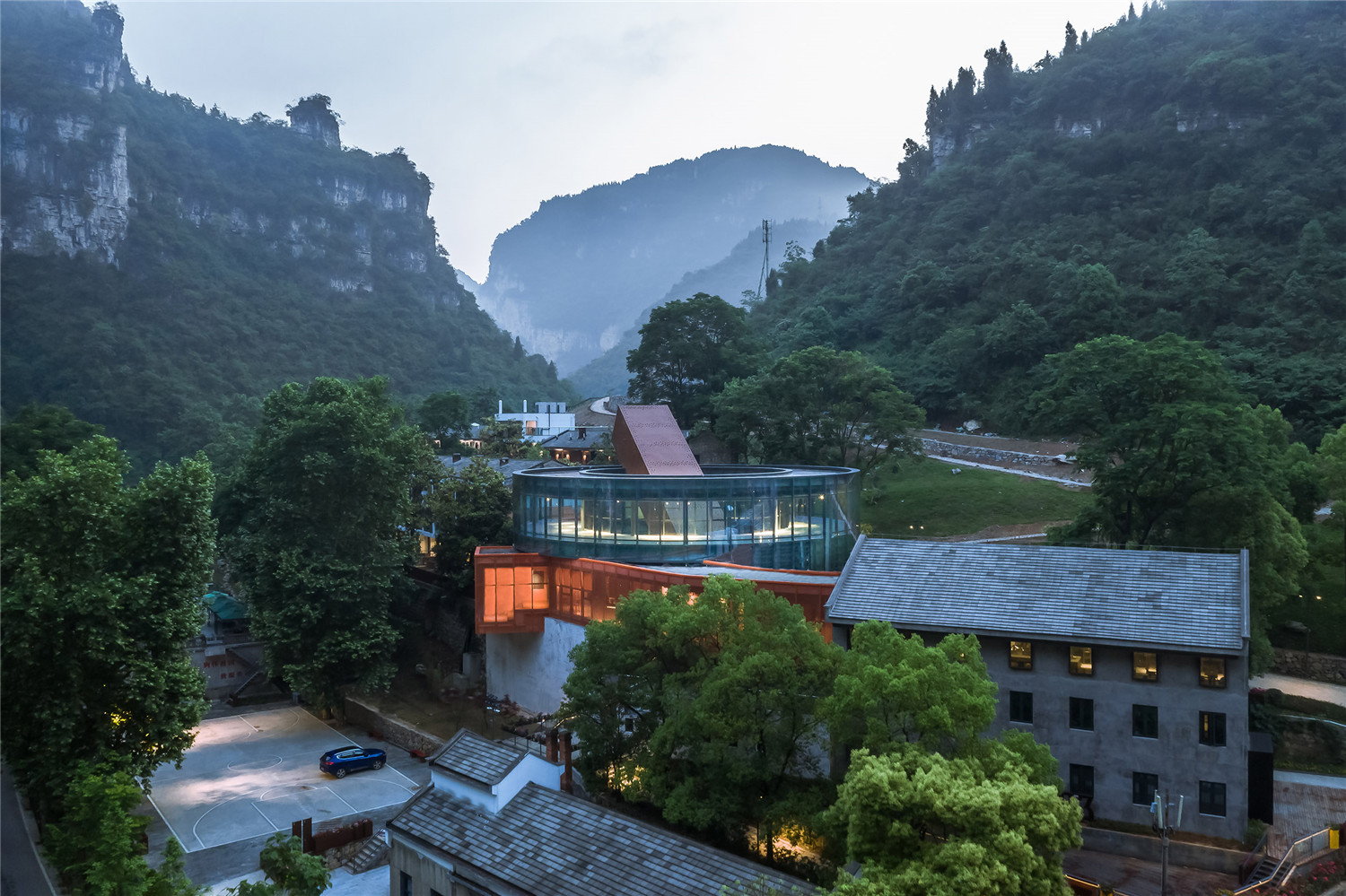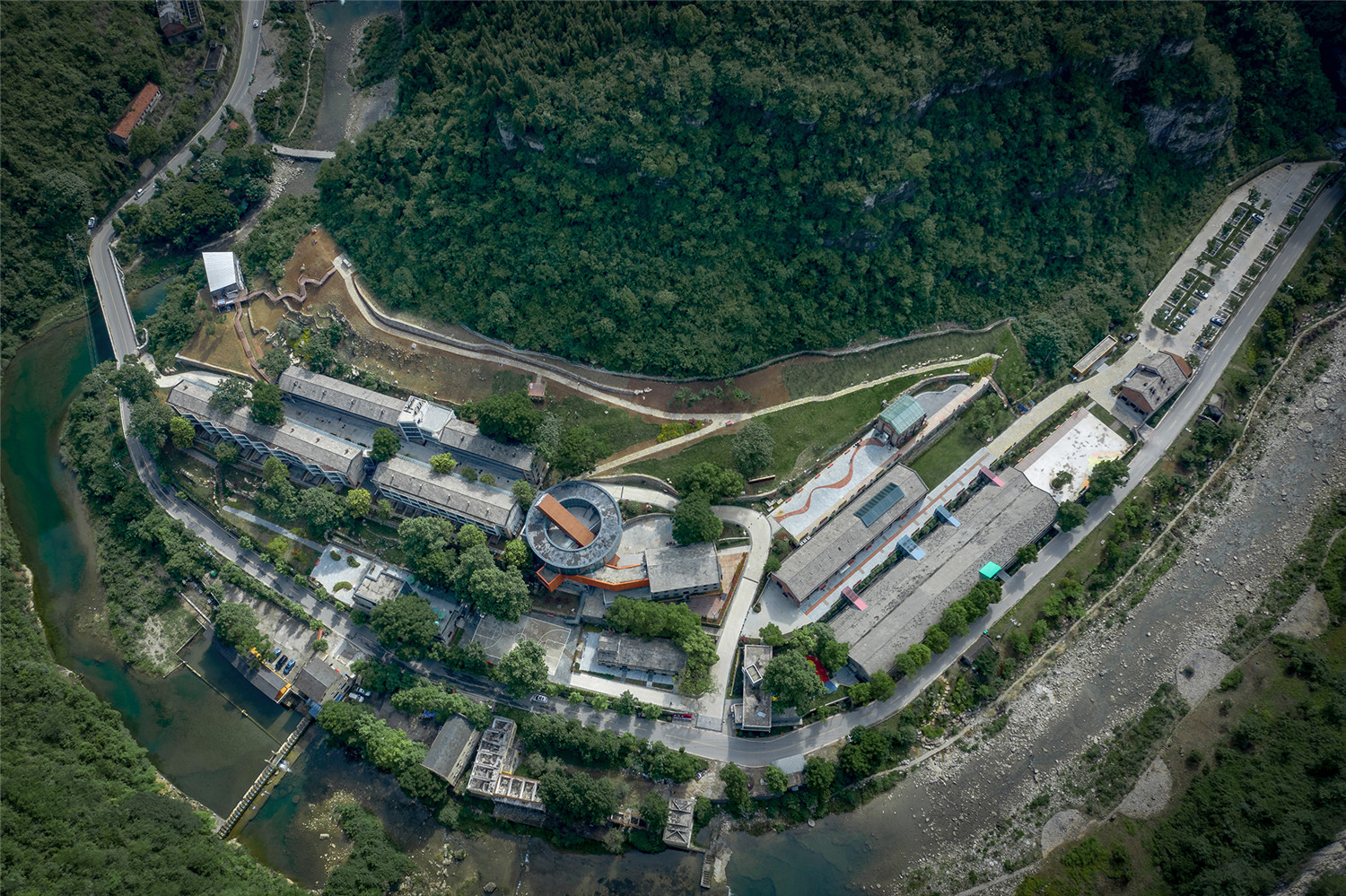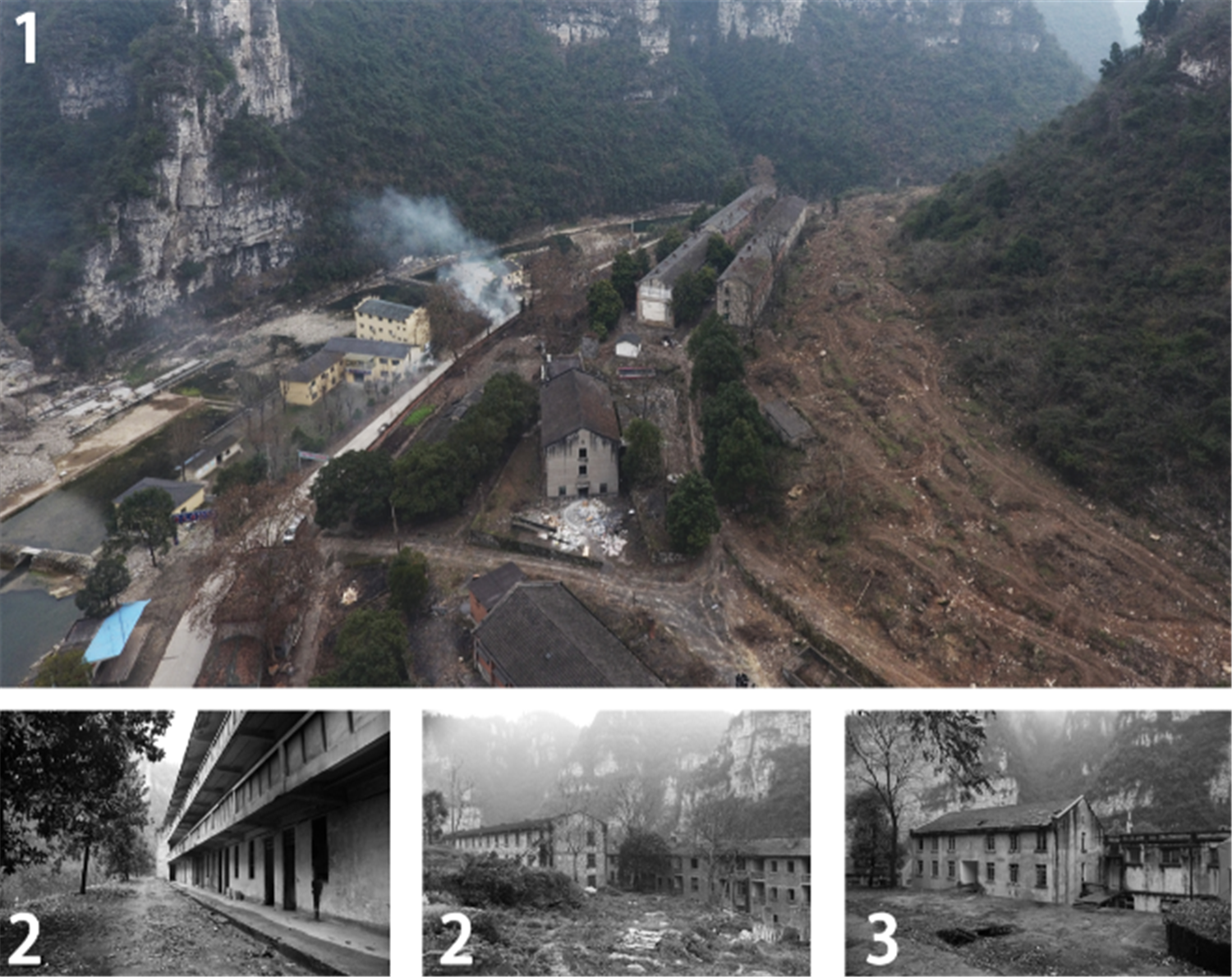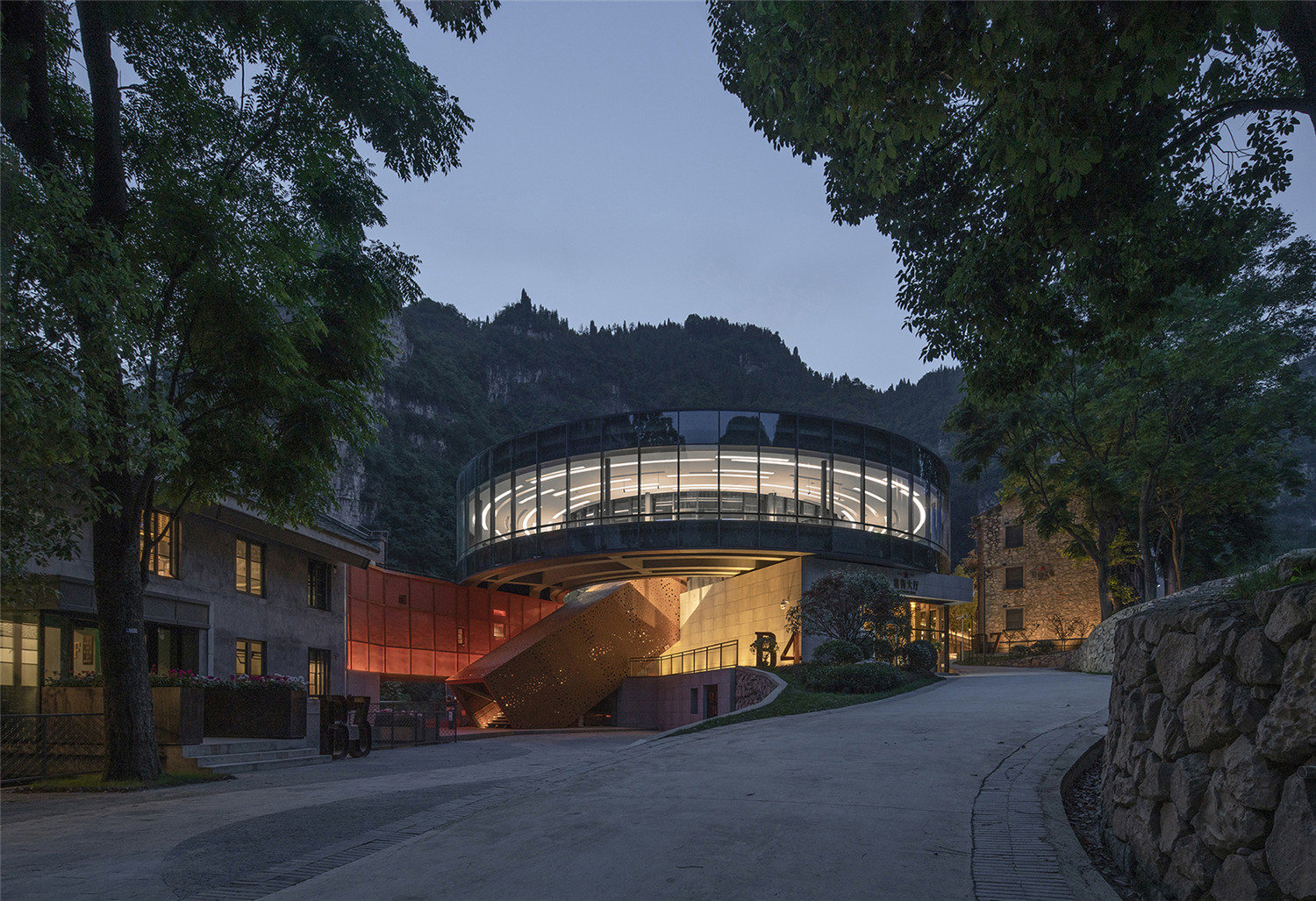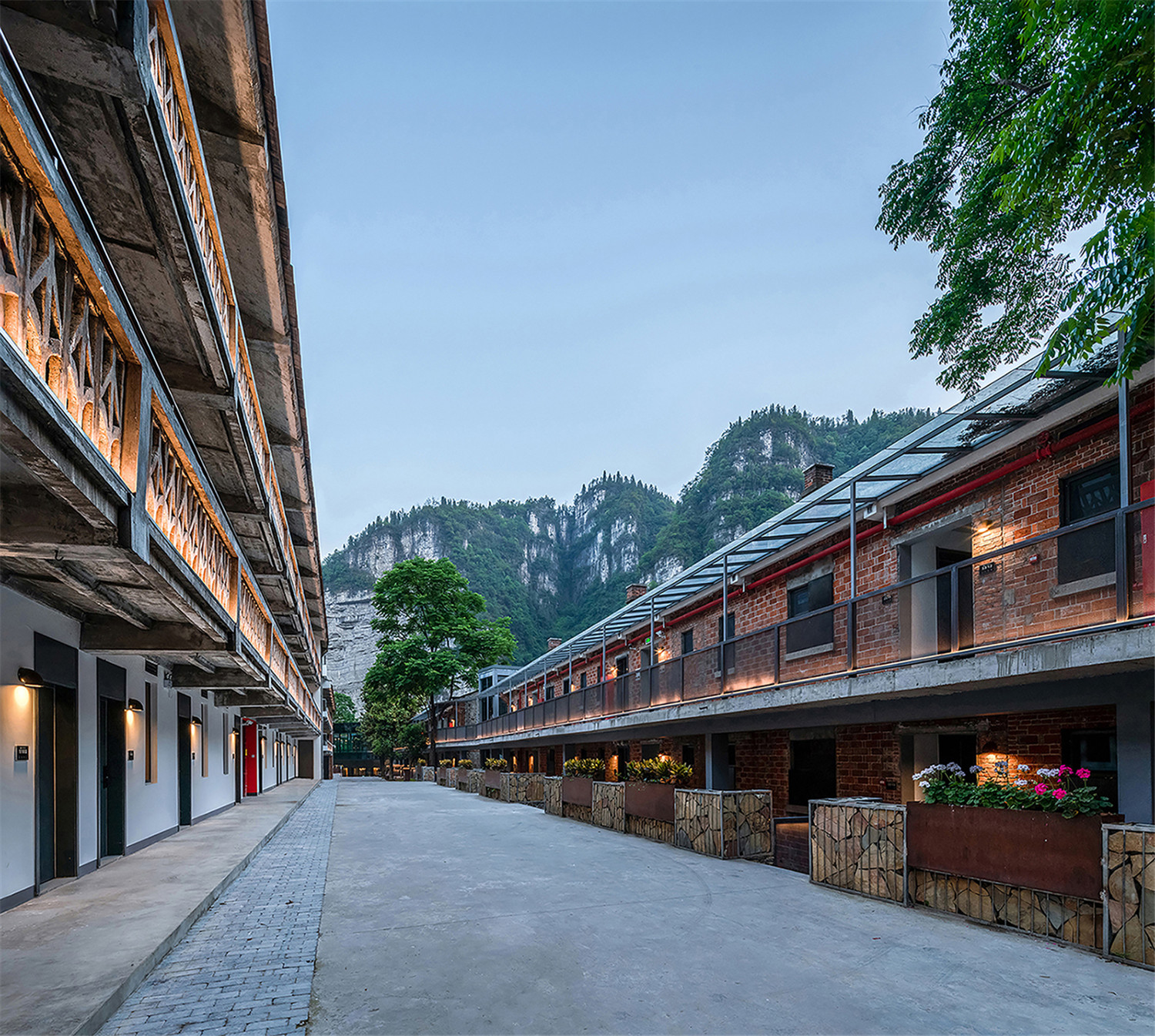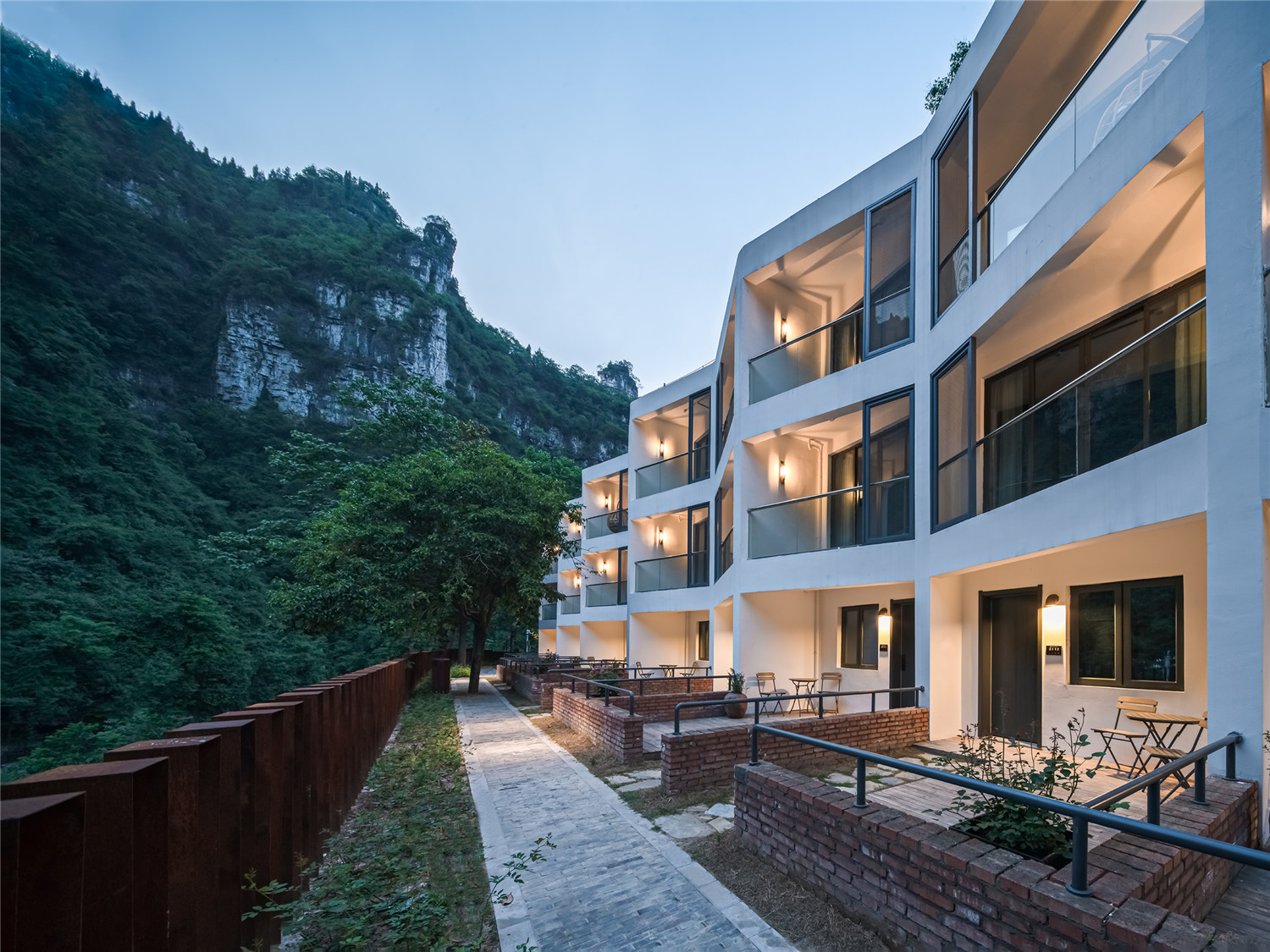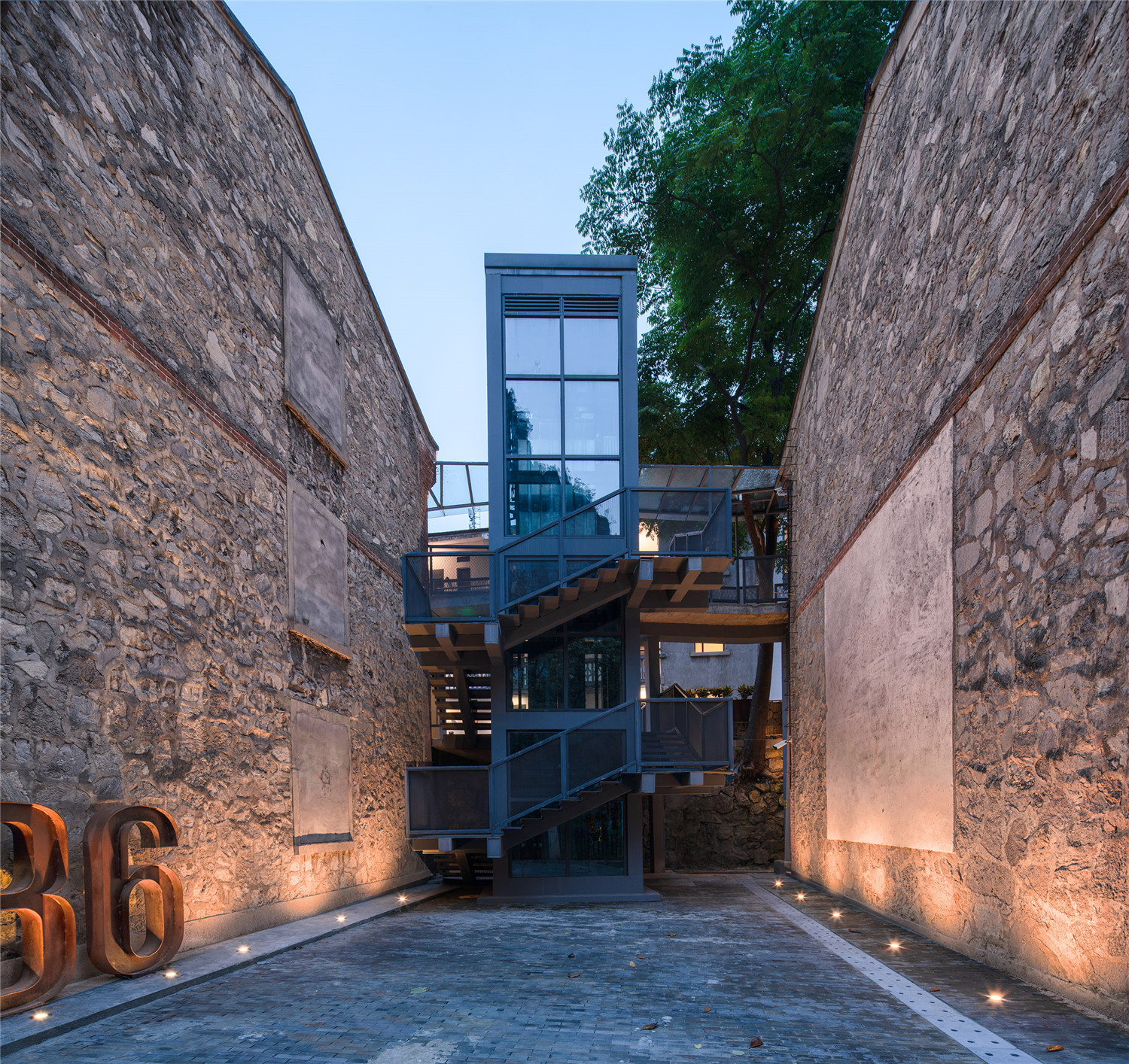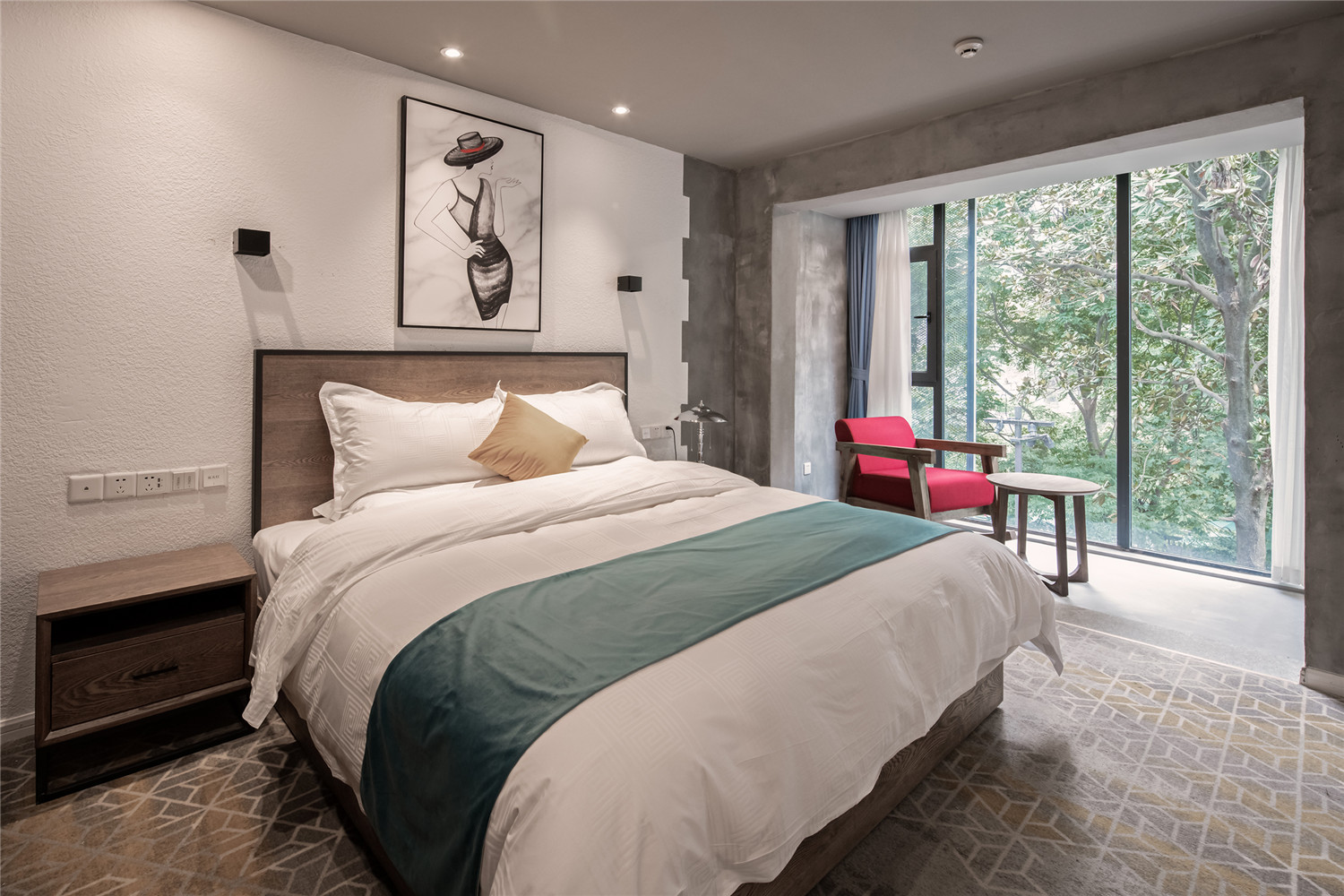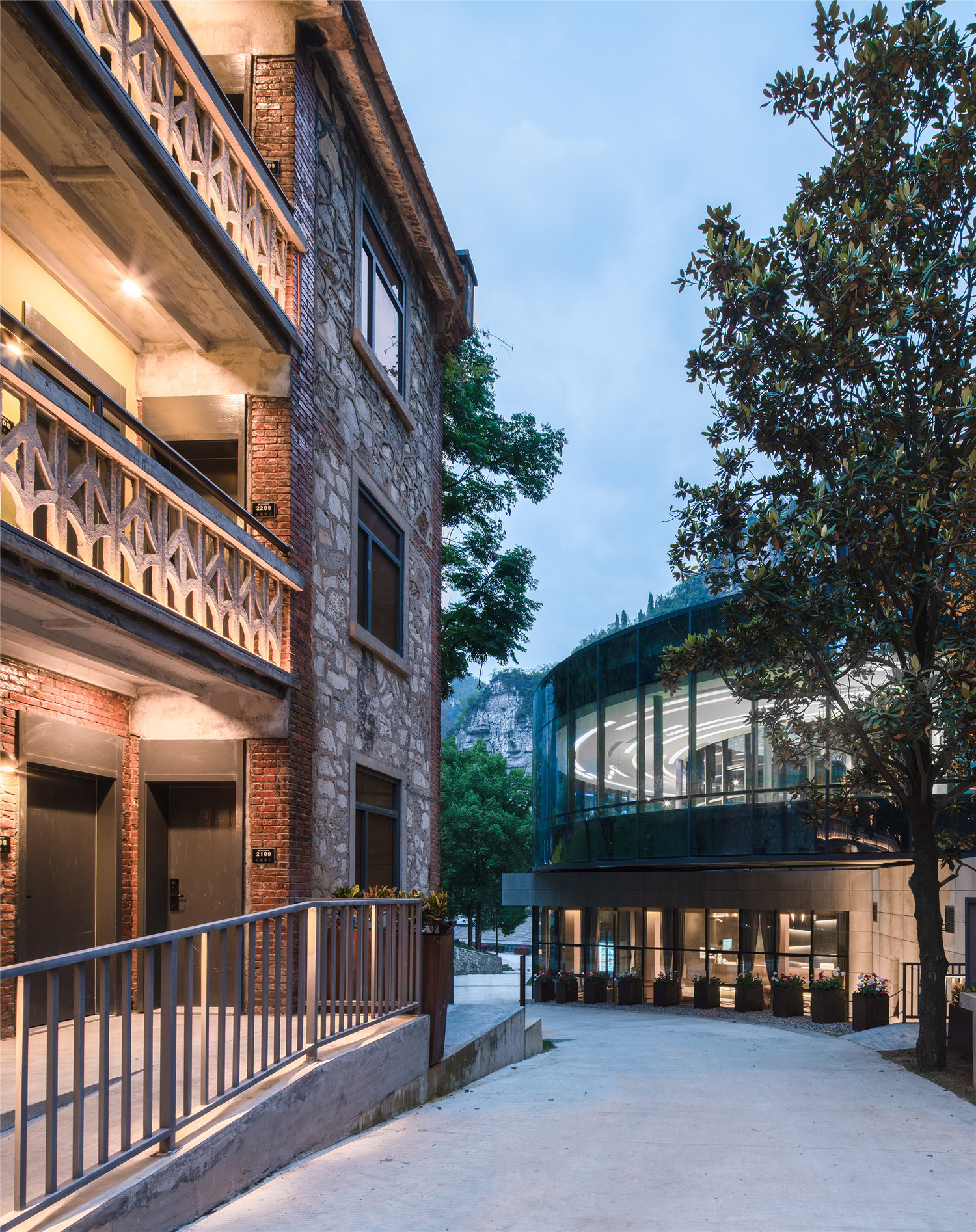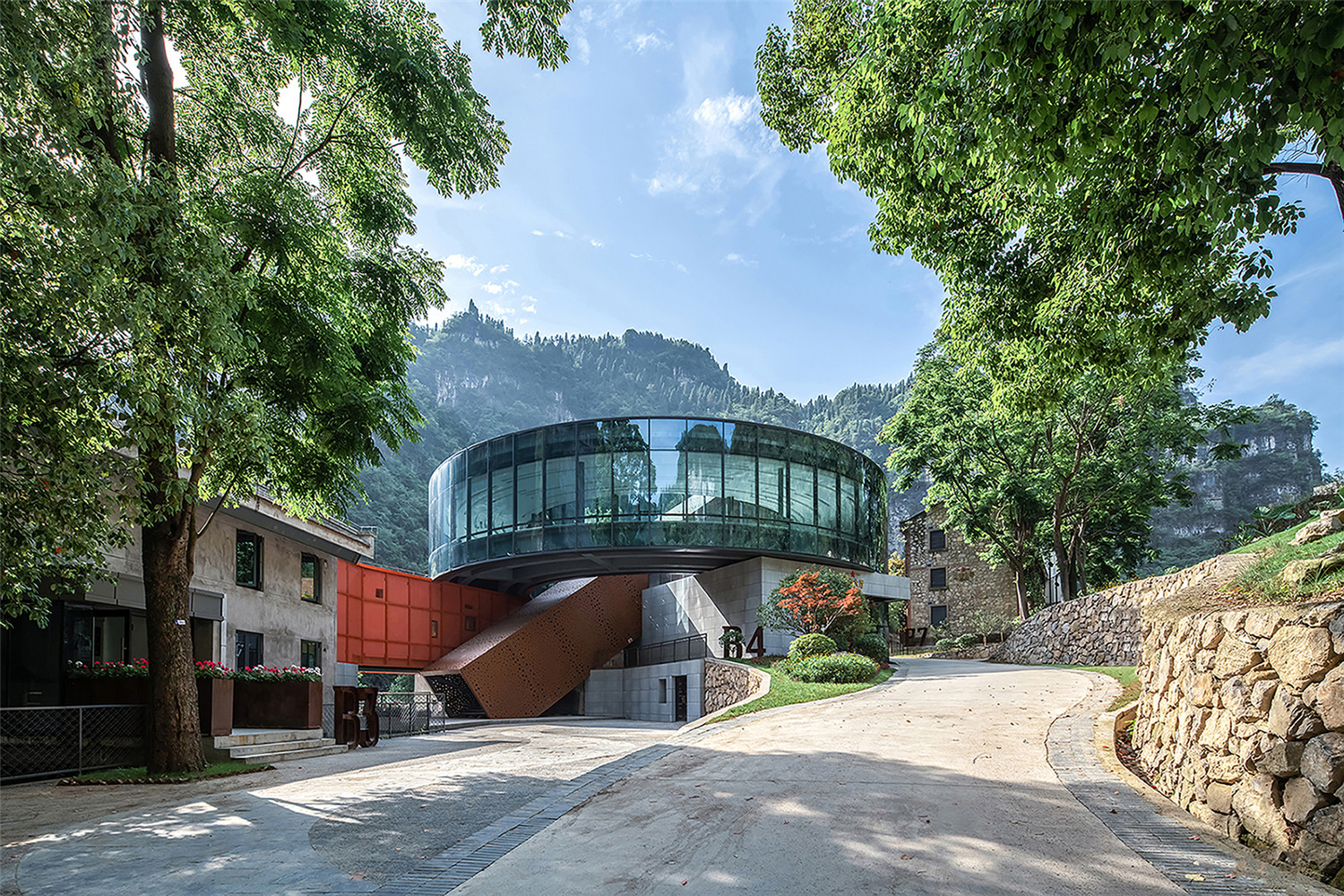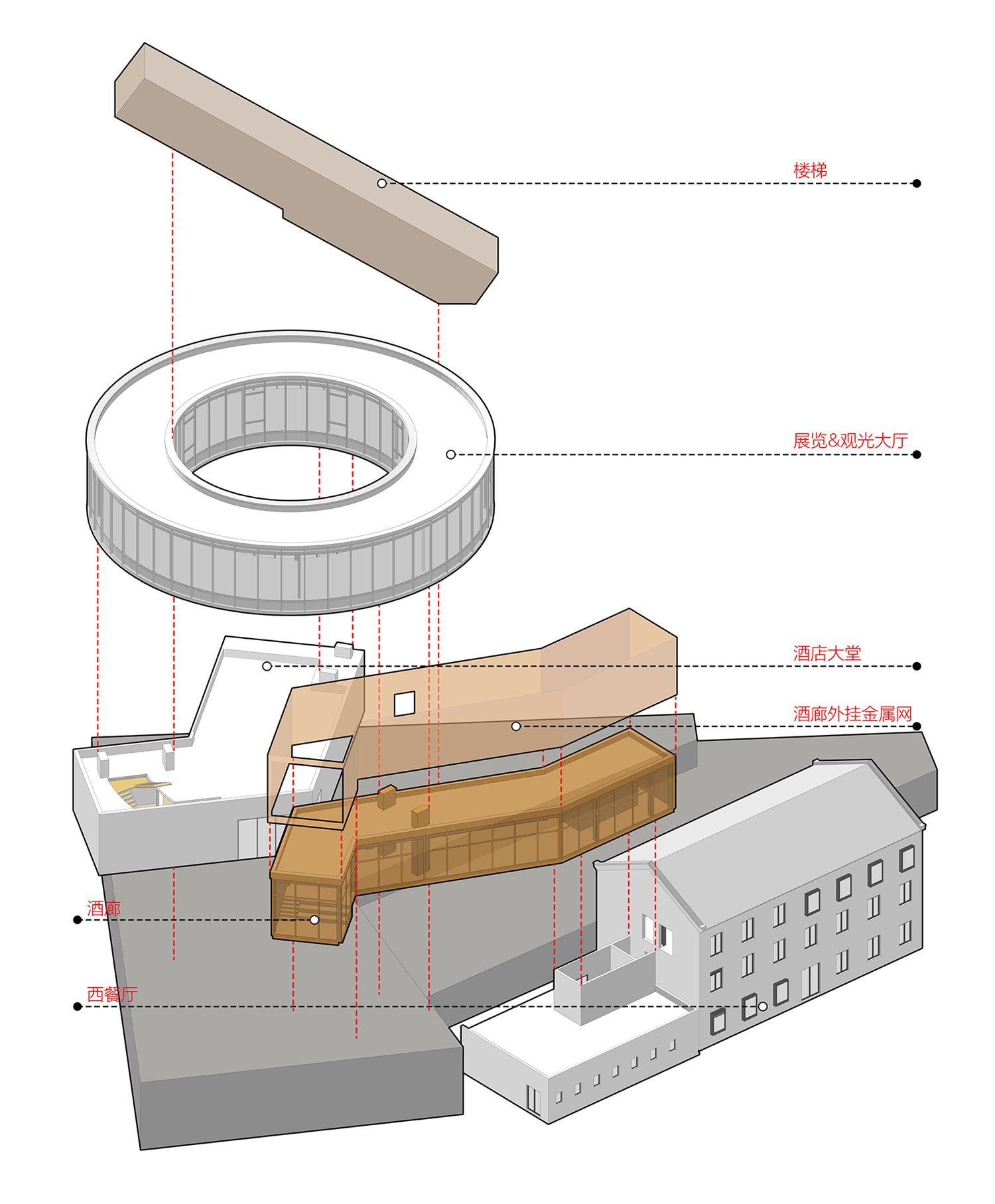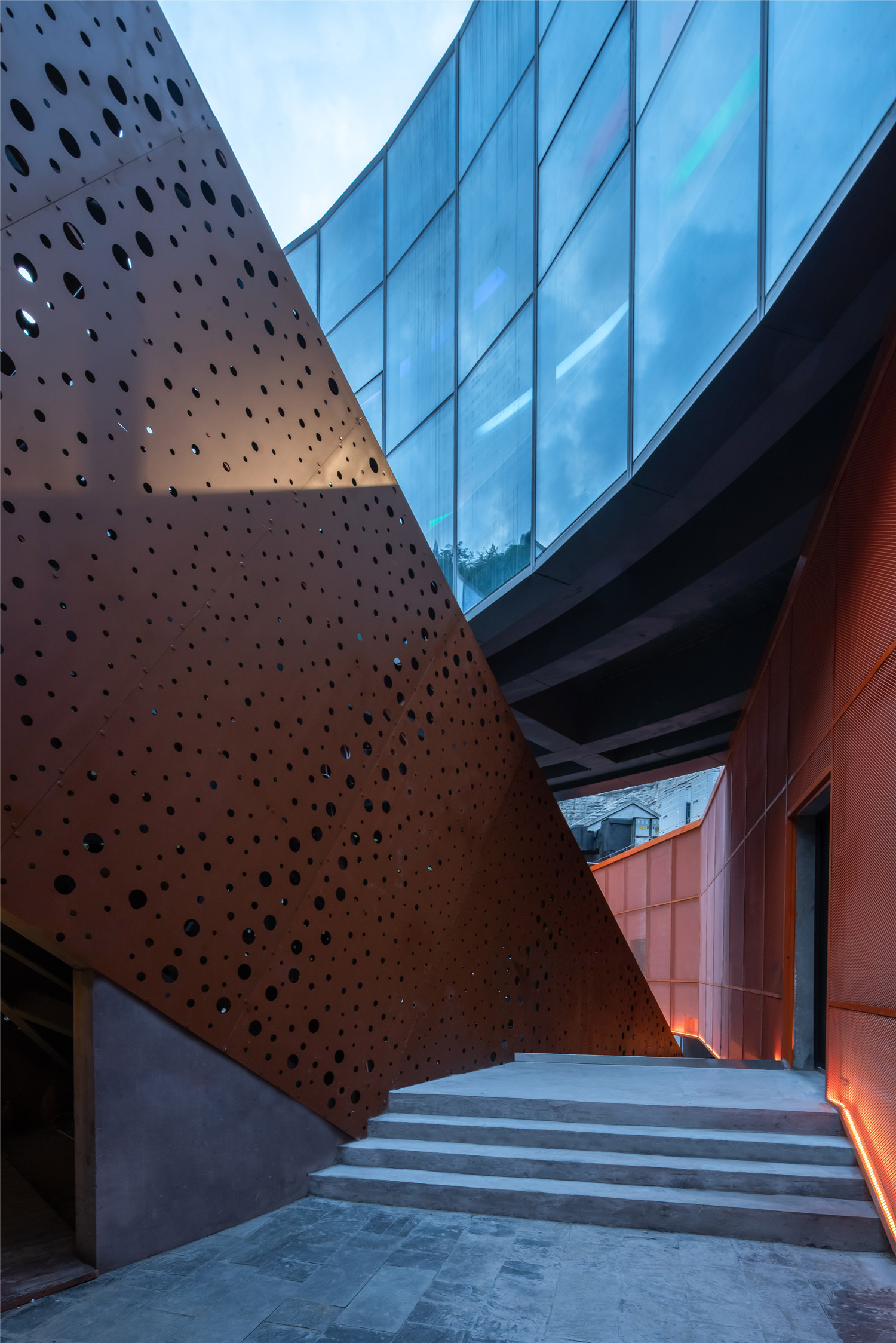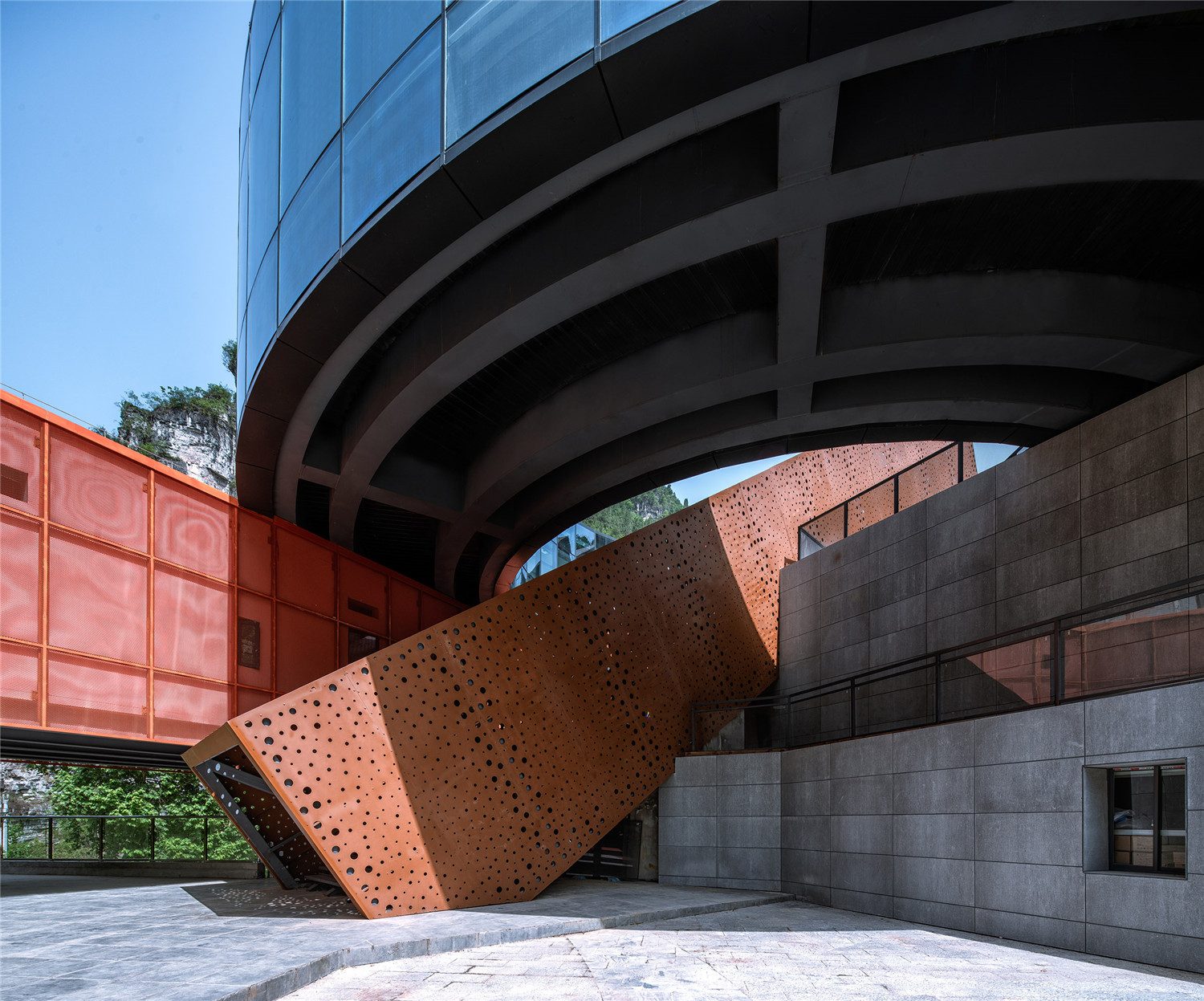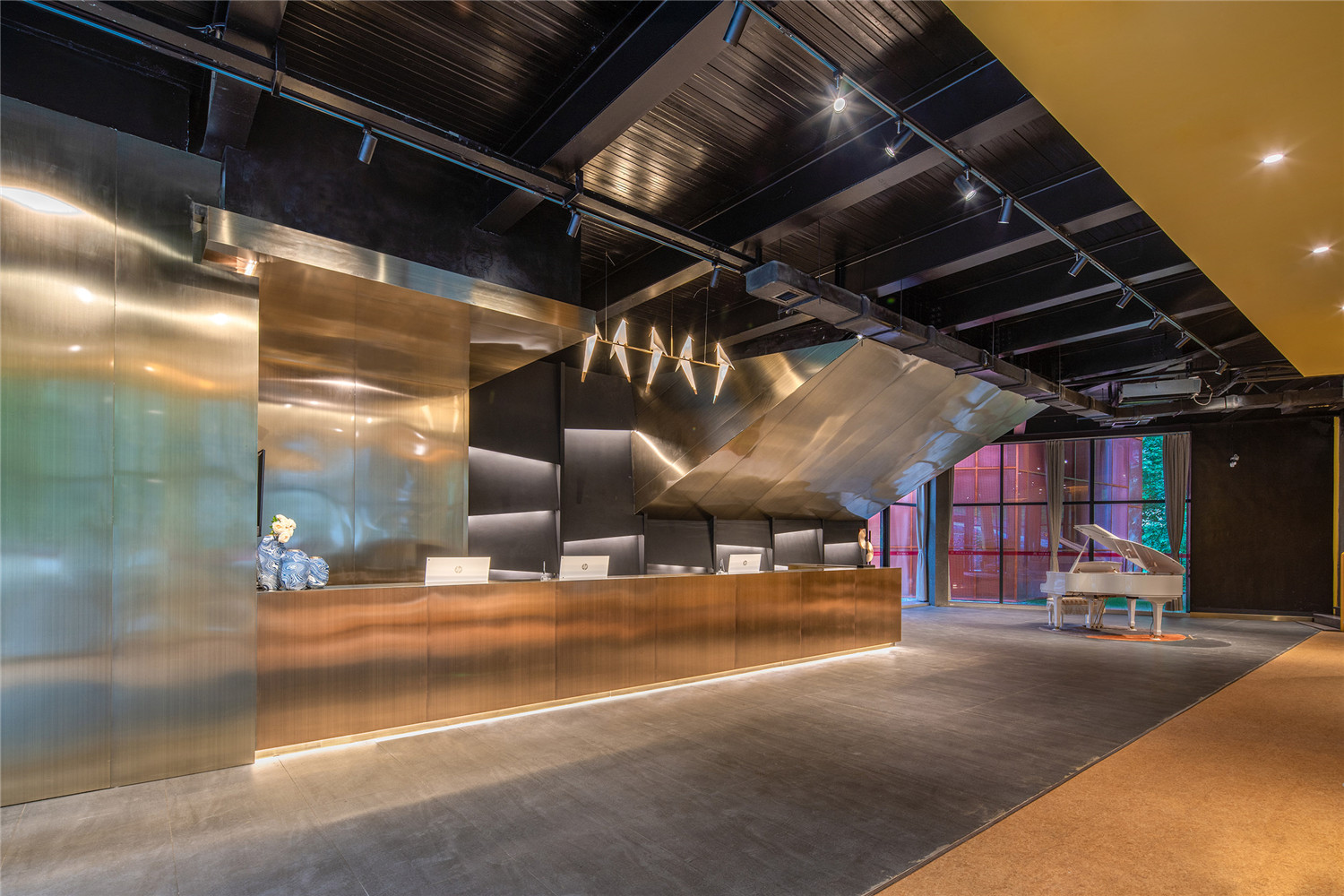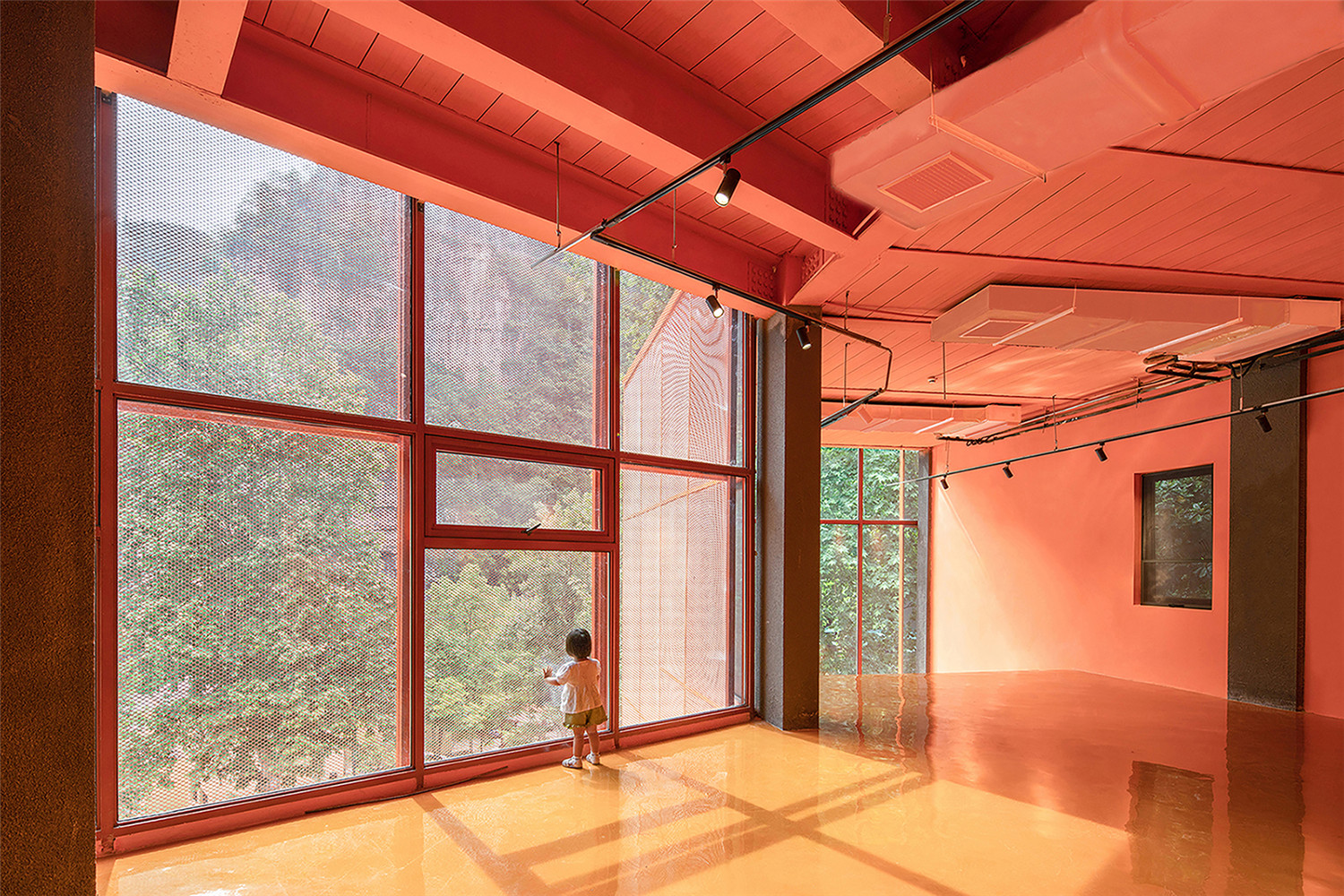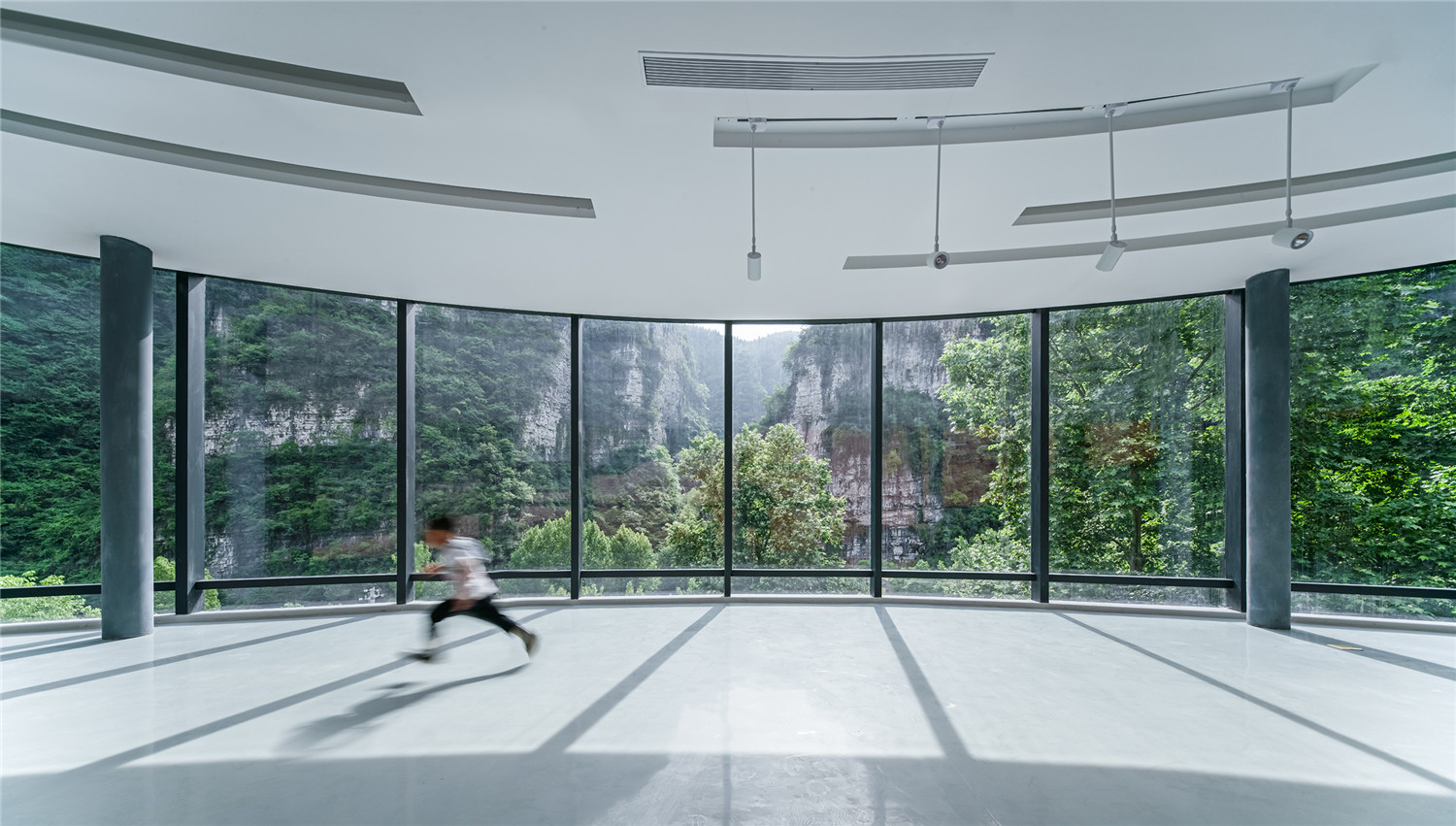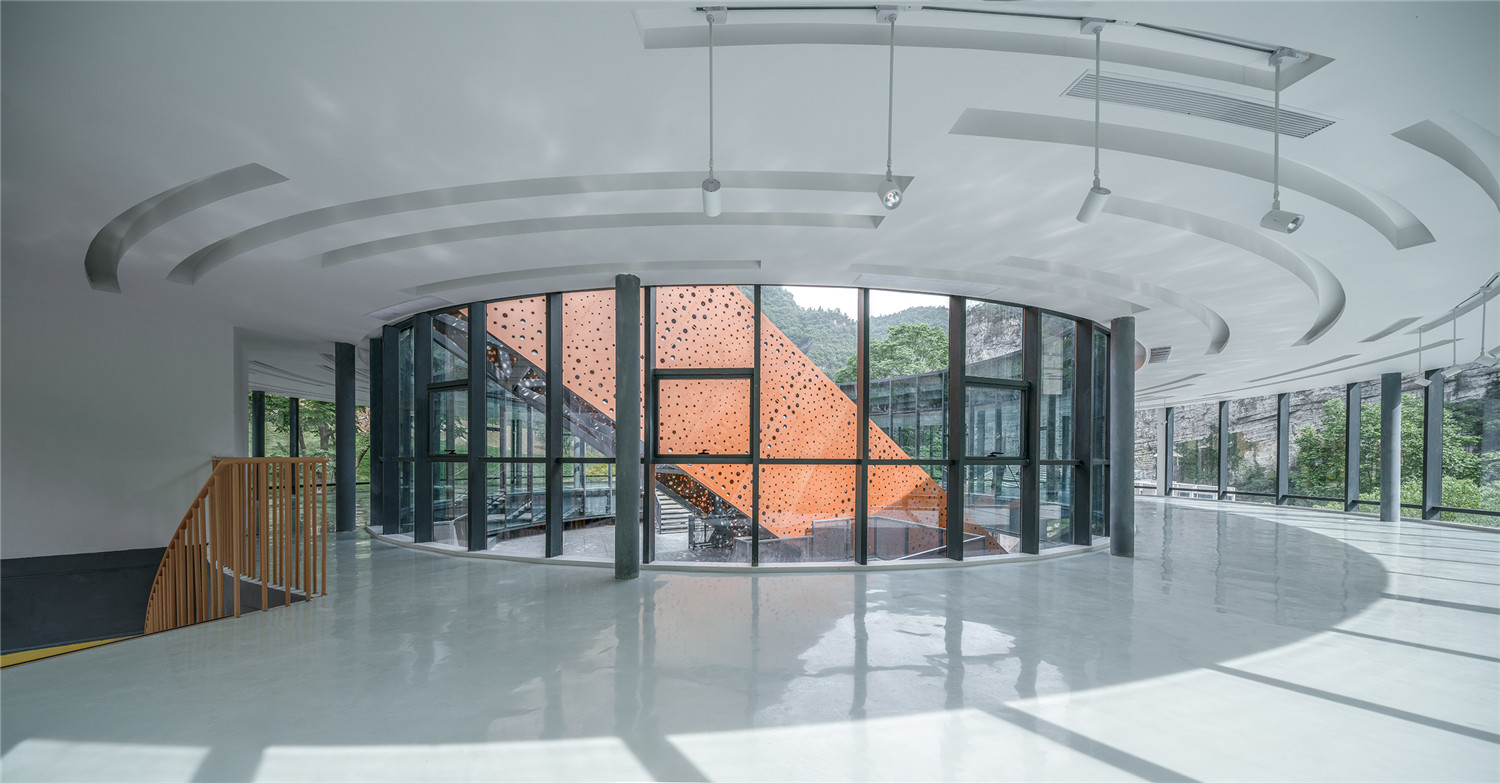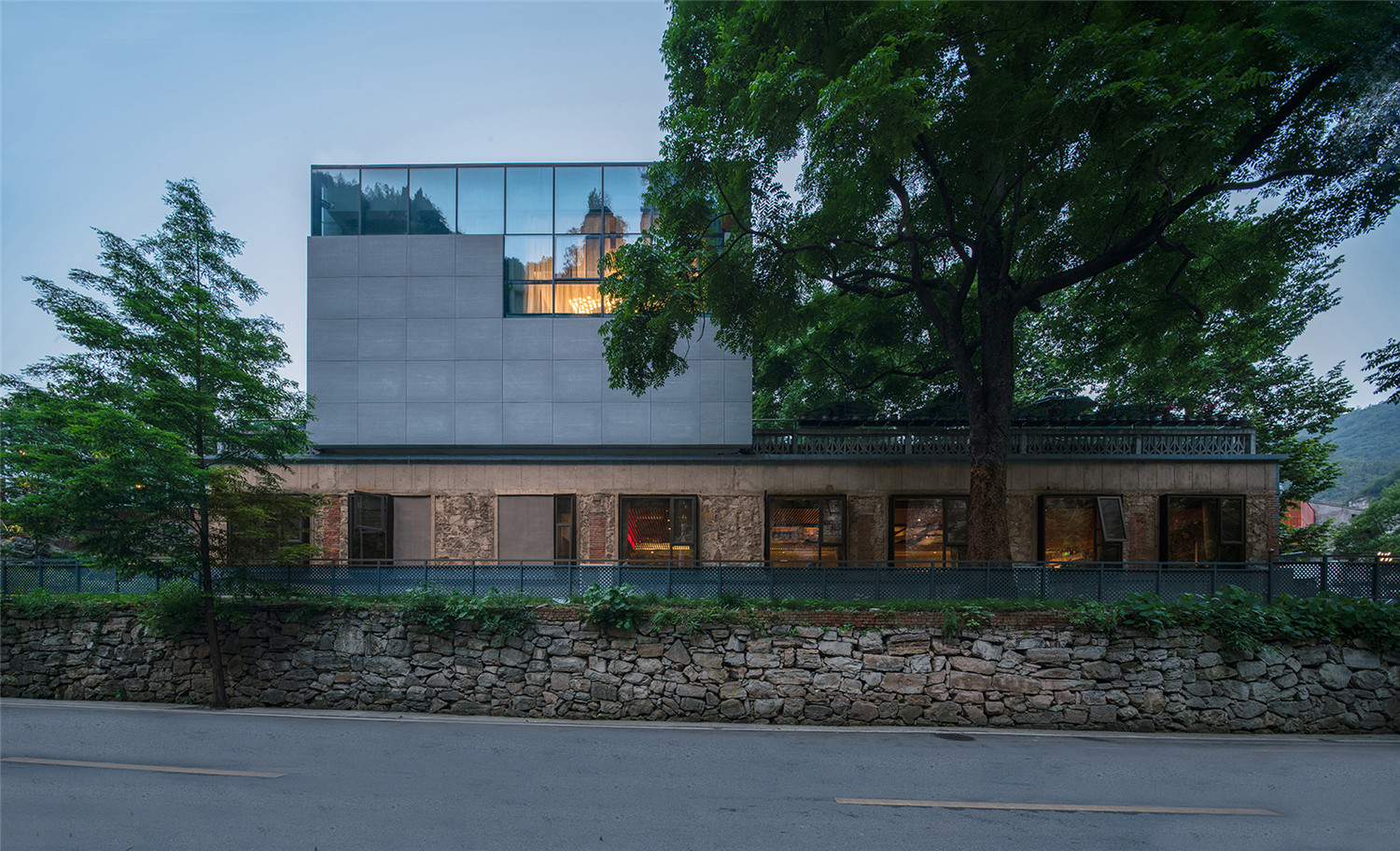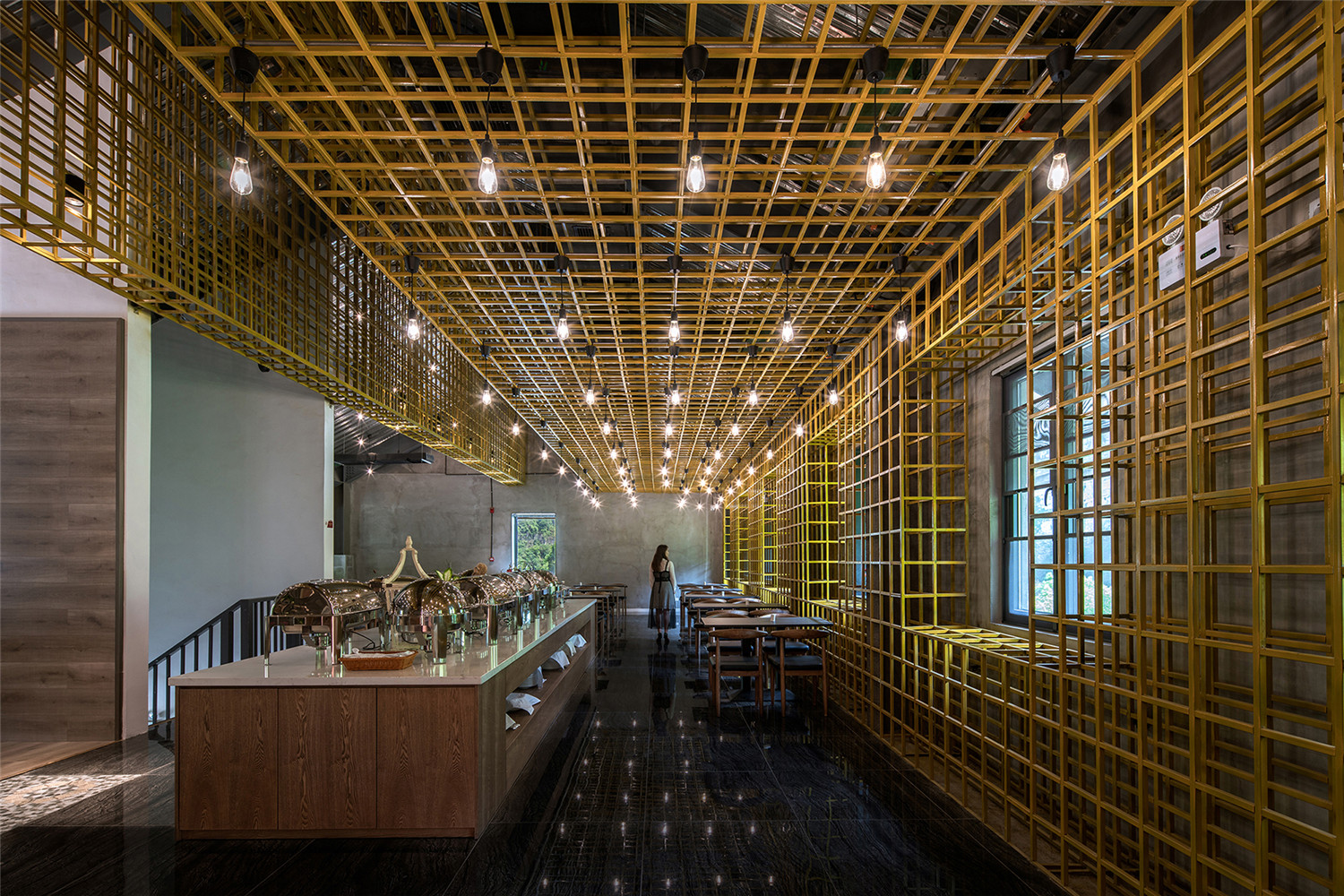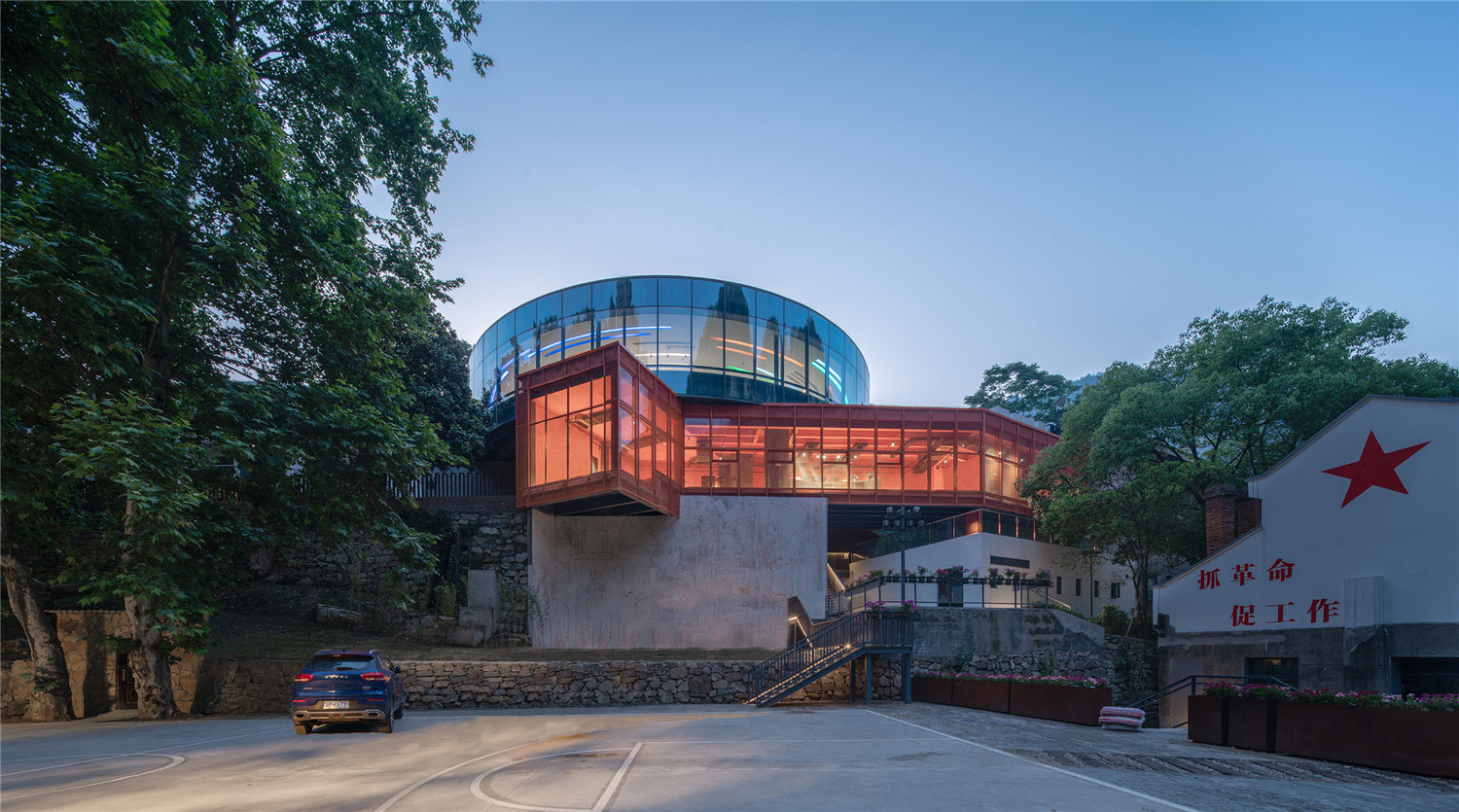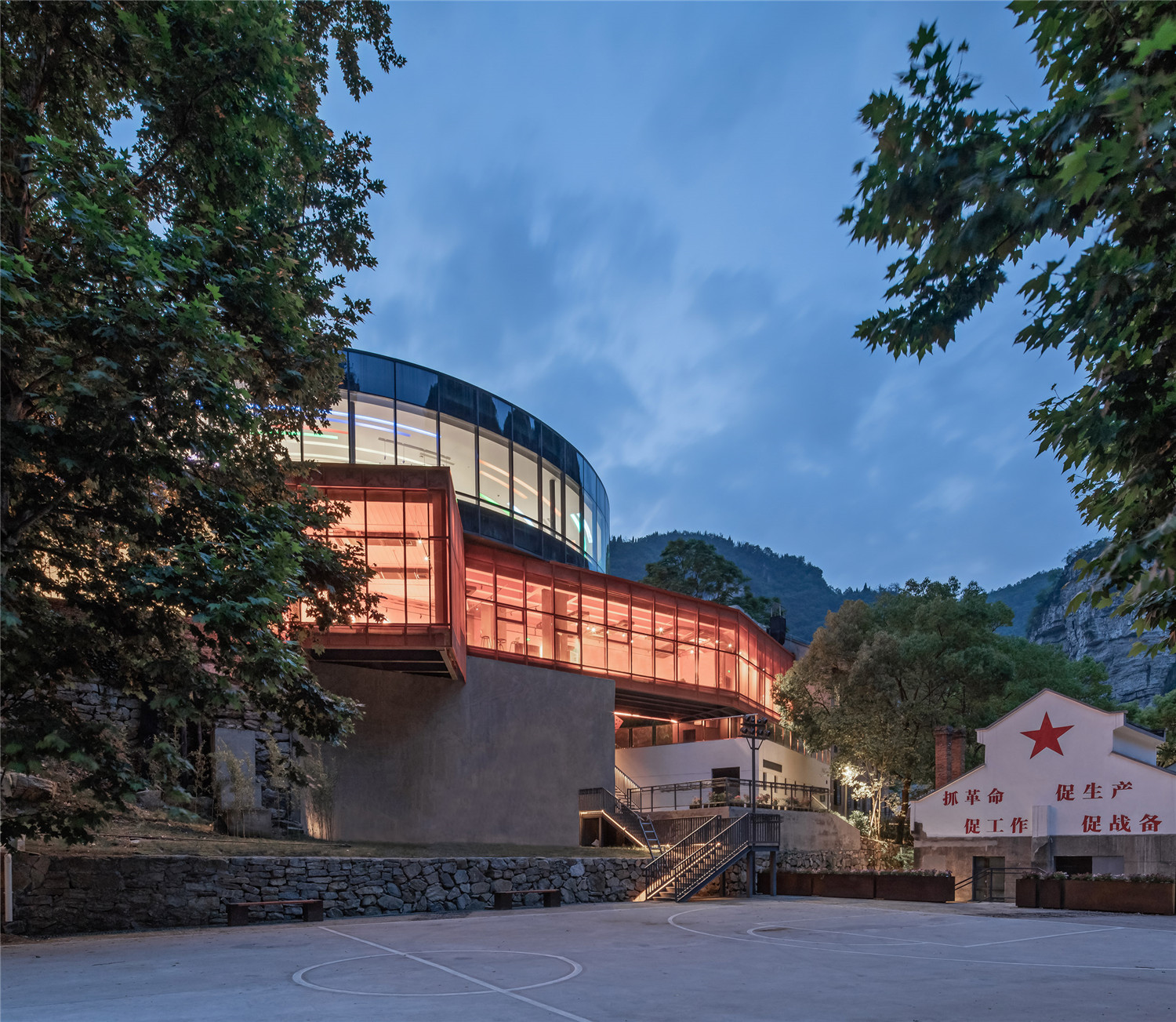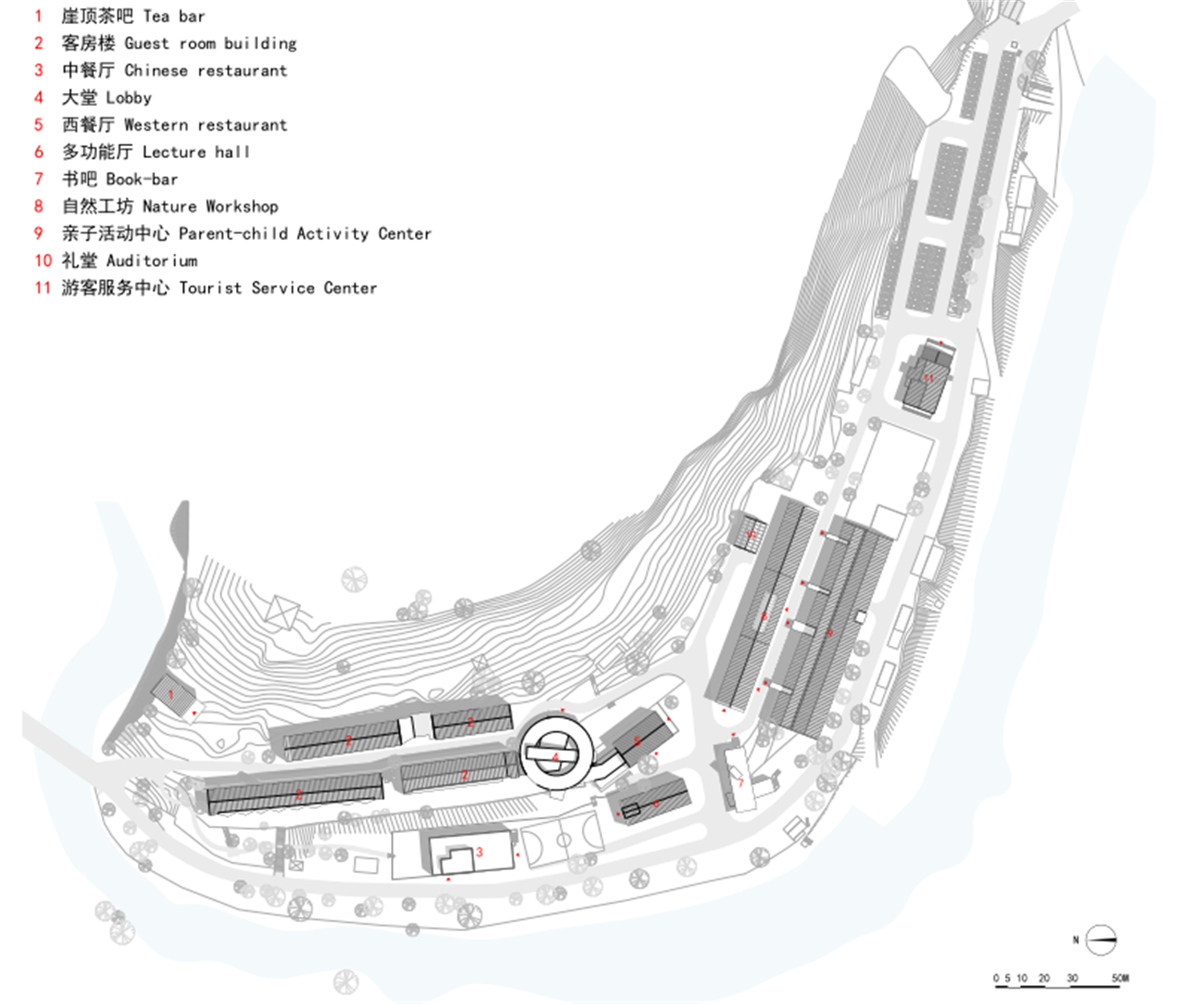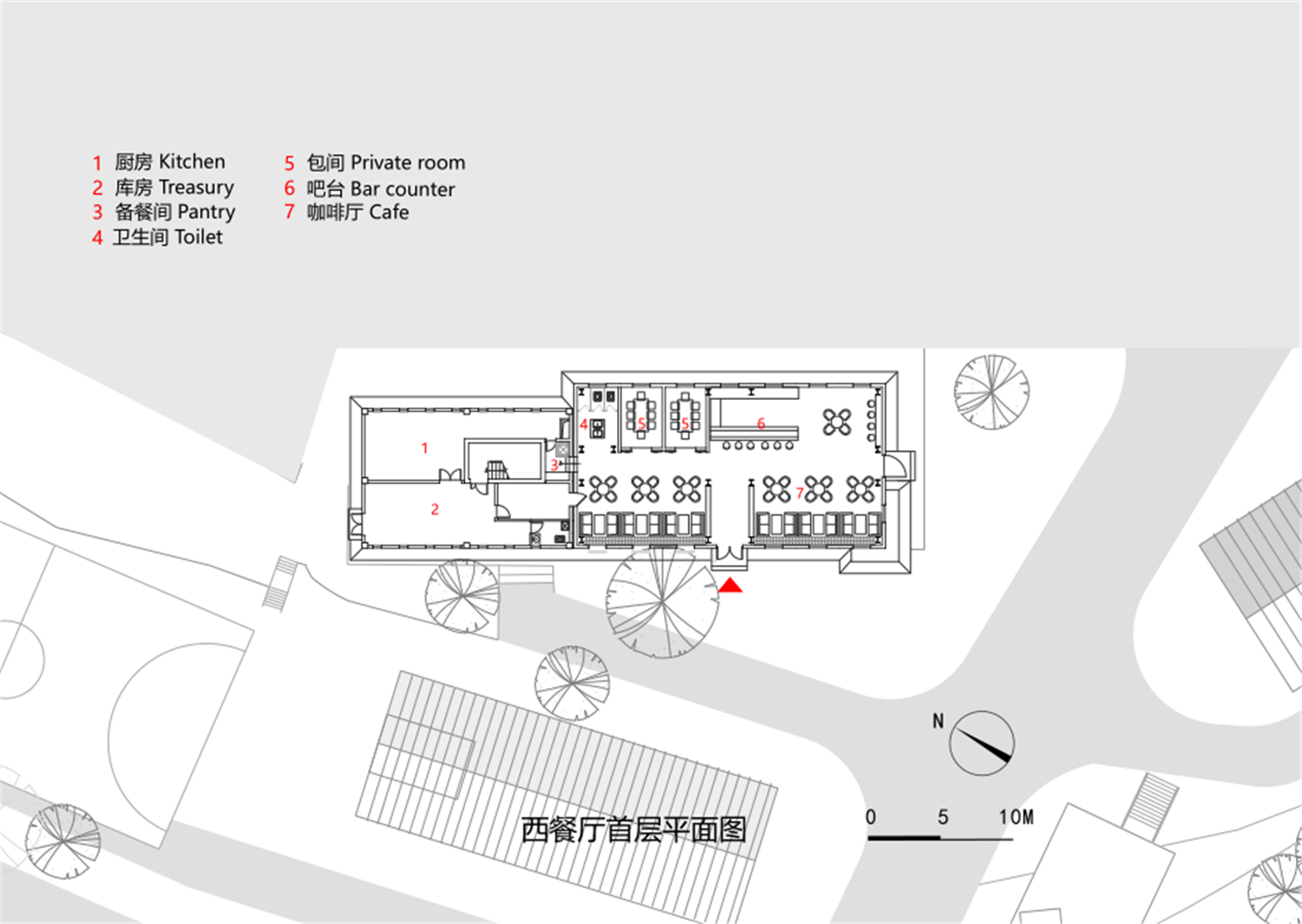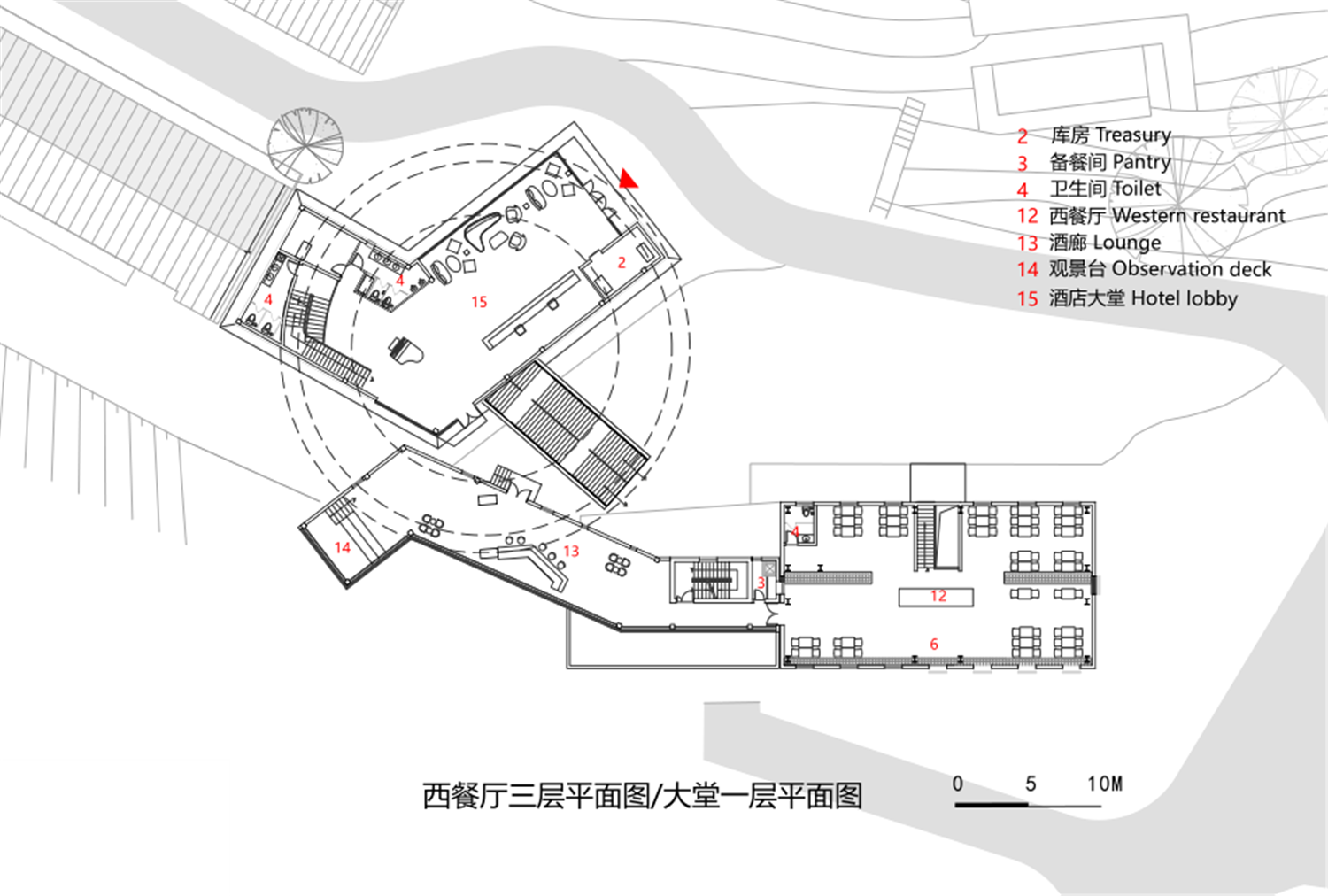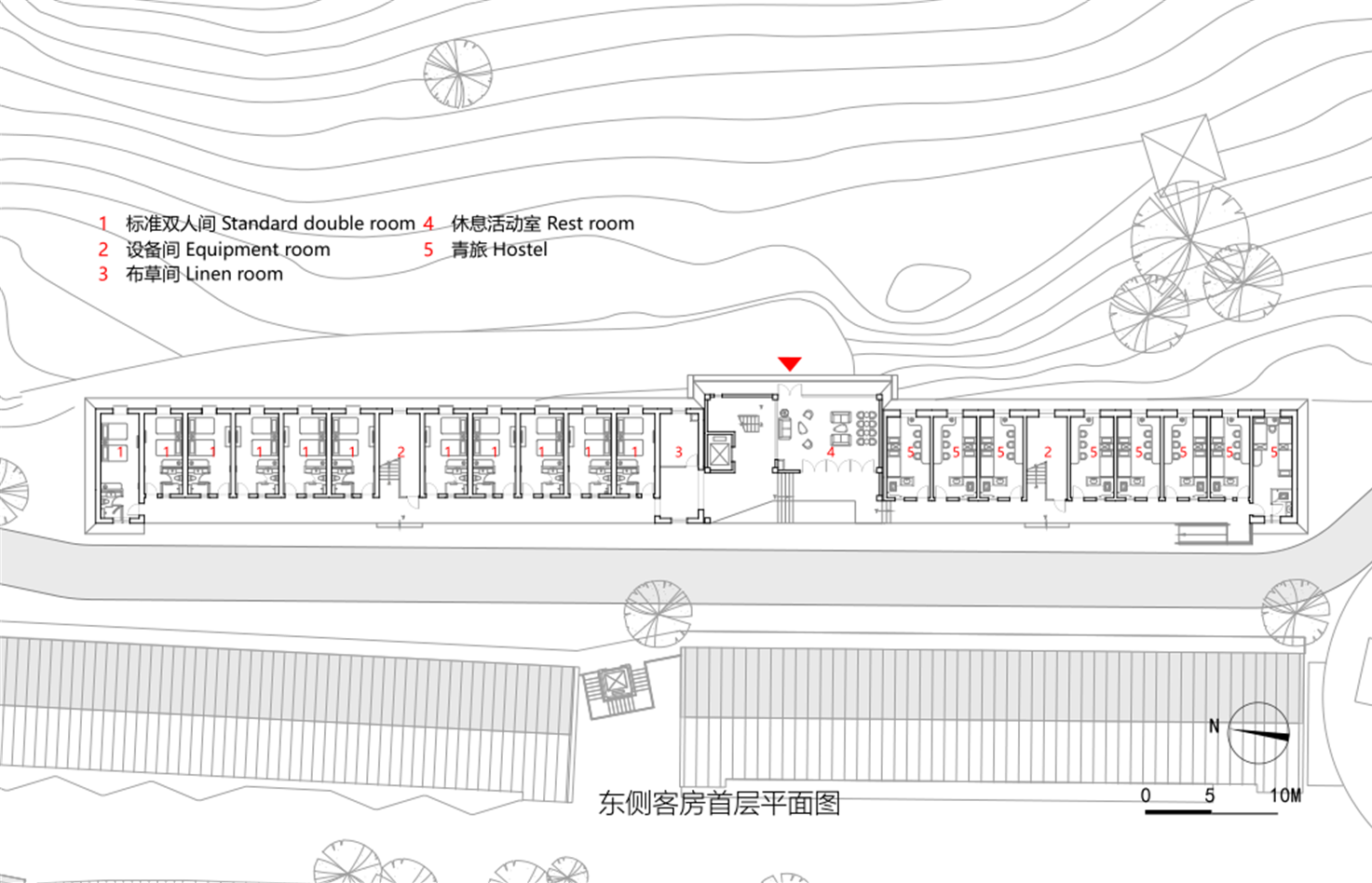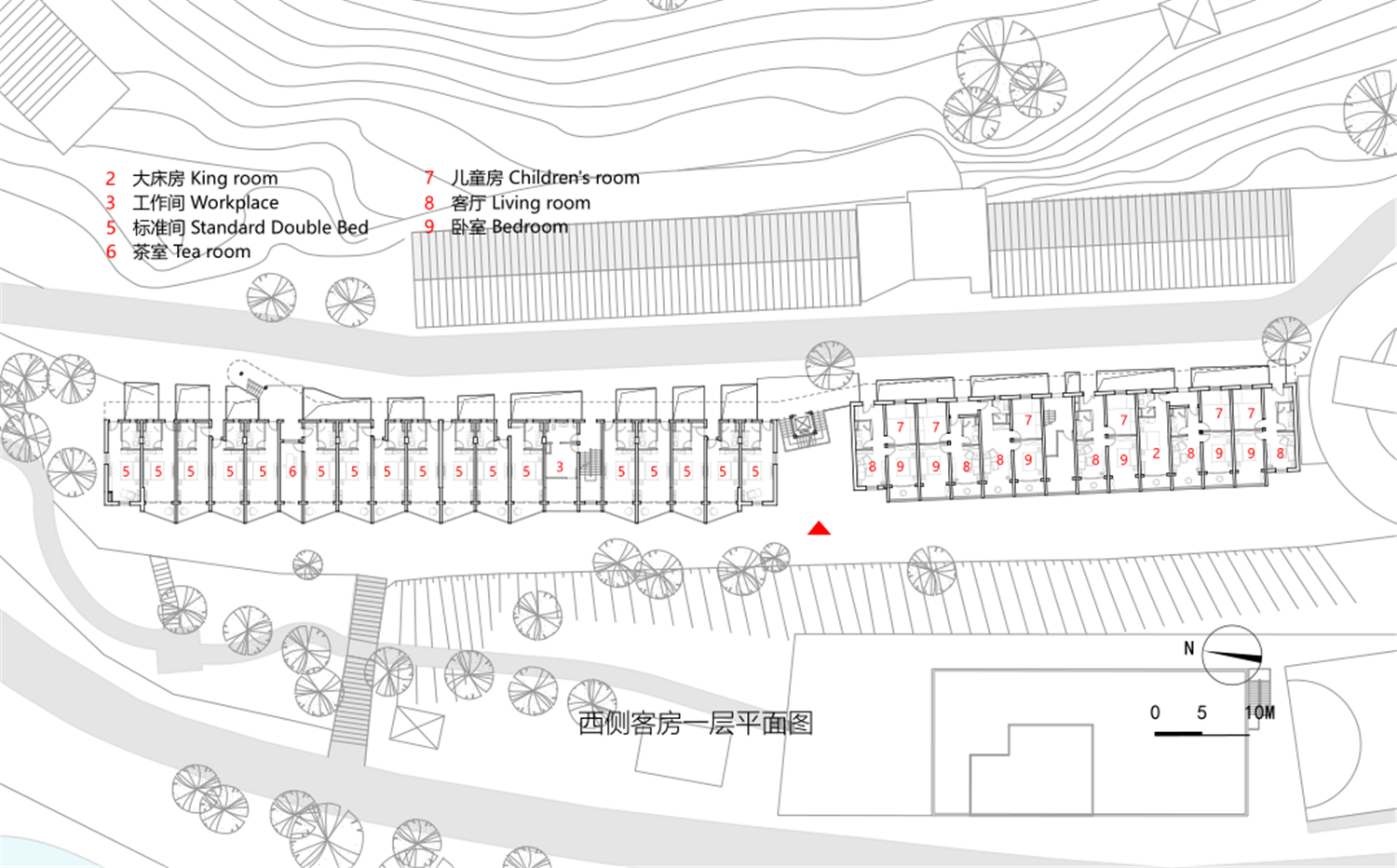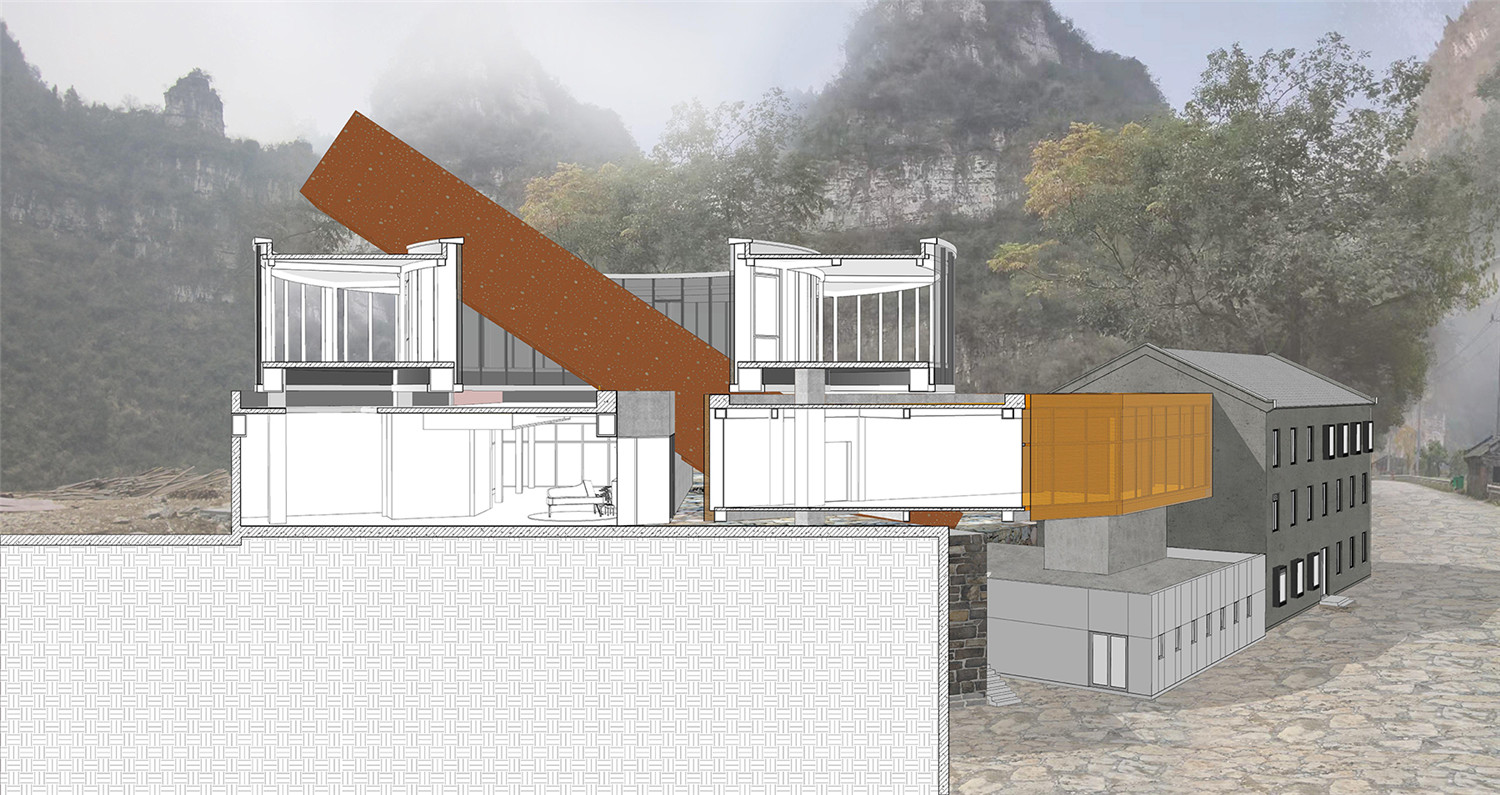背景和原貌:废弃多时,但潜力巨大
Background and original appearance: abandoned for a long time, but with great potential
809工厂位于中国湖北省宜昌市郊的下牢溪中,距离市区约30分钟车程,曾经是老三线兵工厂,1990年代逐渐停产并废弃。项目用地面积约3公顷,建筑面积约1.3万平米,新功能为度假酒店和亲子活动中心。项目旨在通过对这个废弃工厂的改造和再利用,在保护和展现建筑原始面貌的同时,形成新的使用功能,使废弃工业设施复活,进入当代生活。
The 809 factory is located in Xialao Creek, the suburb of Yichang City, Hubei Province, China, which is about 30 minutes’ drive from downtown. Once a military factory, it was gradually shut down and abandoned in the 1990s. The project covers an area of about 3 hectares and a construction area of about 13000 square meters. The new function is a resort hotel and parent-child activity center. The purpose of the project is to protect and show the original appearance of the buildings and form a new use function through the transformation and reuse of the abandoned factory, so as to revive the abandoned industrial facilities and help those enter the contemporary life.
▲809厂区鸟瞰
809厂位于一个峡谷中,喀斯特地貌,场地高差大,地质条件复杂。峡谷名为下牢溪,环境优美、舒适,是宜昌市民夏季避暑的首选地之一。峡谷中有溪流,常年有水,且水质优良,适合游泳和休闲。改造前,该区域已经有大量的农家乐和小型度假游乐场。809厂位于下牢溪中段,与溪流关系紧密,具备很好的自然环境和产业基础。
The 809 factory is located in a canyon with karst landform, large site height difference and complex geological conditions. The canyon is named Xialao Creek, with beautiful and comfortable environment. It is one of the best summer resorts for Yichang citizens. There are streams in the canyon, with water flowing all year round, and the water quality is excellent, suitable for swimming and leisure. Before the renovation, there had been a large number of farmhouses and small resorts in the area. The 809 factory is located in the middle part of Xialao Creek, which is closely related to the stream and has a good natural environment and industrial foundation.
809厂曾是西部地区重要的兵工厂,以生产防毒面具为主。改造前,工厂已经停产多时,期间也曾出租给民营企业。厂房中的机械已经全部被移除,整个厂区只留下建筑本体。调研中,建筑师发现现存建筑主要分为三类:空间跨度大的厂房,中等尺度的设备用房,如锅炉房等,及空间尺度小的宿舍和办公建筑。原建筑建设时期跨域1950-70年代,主要为砖混预制楼板结构形式,建造工艺包括毛石砌筑,砖墙,预制混凝土楼板,大多数已经不符合当下的建筑法规,需要进行结构加固和再处理。但另一方面,正是这些不同时期的建造痕迹产生了极大的文化价值,反映了那个时期老三线工厂的历史记忆和建筑文化价值。设计需要保留原有建筑的大部分外立面,同时又要满足新的使用和法规要求,这给设计带来了很大的困难。
The 809 factory used to be an important military factory in the western region, mainly producing gas masks. Before the transformation, the factory had been shut down for a long time, during which it was also rented to private enterprises. All the machinery in the plant has been removed, leaving only the building itself. In the survey, architects found that the existing buildings are mainly divided into three categories: workshops with large space span, equipment rooms with medium scale, such as boiler house, and dormitories and office buildings with small space scale. The original building construction period is from 1950s to 1970s, mainly in the form of brick concrete precast floor structure. The construction technology includes rubble masonry, brick wall, precast concrete floor. Most of them are not in line with the current building laws and regulations, and need to be strengthened and reprocessed. But on the other hand, it is these construction traces in different periods that produce great cultural value, reflecting the historical memory and architectural cultural value of the old third line factory in that period. The design needs to retain most of the facade of the original building, but also to meet the new use and regulatory requirements, which brings great difficulties to the design.
▲场地原貌
设计原则和思路
Design principles and ideas
设计希望通过对老三线工厂遗址的改造,赋予空间新的生命,使之从废弃状态重新复活。在新的功能业态,及新空间的双重作用下,业主和建筑师希望重构一个新809厂。改造后,它将成为宜昌人短期度假的首选,并为城市提供一处具有品味和调性的精致生活场所。
Through the reconstruction of the old third-front factory site, the design hopes to give new life to the space and revive it from the abandoned state. Under the dual function of new business form and new space, the owners and architects hope to reconstruct a new 809 factory. After reconstruction, it will become the first choice of Yichang citizens for short-term vacation, and provide a delicate living place with taste and tonality for the city.
▲新建大堂插入老建筑和环境中
设计从场地规划开始,将建筑、室内、景观、照明一体化考虑,最大限度的保留原建筑的工业特征和历史信息,并进行改造再利用。设计首先对工业遗产进行保护,通过结构加固等措施,保留建筑外观原貌。之后,选择性的利用原建筑空间植入新功能,如原宿舍改为酒店客房,原锅炉房改为礼堂,原办公楼和设备用房改为餐厅、接待中心等。在此基础上,在场地重要节点位置设置新公共建筑,形成空间和视觉上的锚点,如酒店大堂,区域入口处的书吧,崖顶的茶吧等。新建筑与老建筑在形式和材料上刻意进行了区分,形成戏剧性的对话关系,也清晰的标明了两个不同历史阶段的空间特点和建筑语言。
The design starts from the site planning, considers the integration of architecture, interior, landscape and lighting, retains the industrial characteristics and historical information of the original building to the maximum extent, and carries out transformation and reuse. First of all, the design protected the industrial heritages and preserved the original appearance of the buildings through structural reinforcement and other measures. After that, the original building spaces were selectively used to implant new functions, incl. changing the original dormitory into hotel rooms, the original boiler-house into auditorium, the original office building and equipment rooms into restaurant, reception center, etc. On this basis, new public buildings are set up at important nodes of the site to form space and visual anchor points, such as hotel lobby, book bar at the entrance of the area, tea bar at the top of the cliff, and so on. The new building and the old building are deliberately distinguished in form and material, forming a dramatic dialogue relationship, and clearly indicating the spatial characteristics and architectural language of the two different historical stages.
场地中的主要树木被保留,新建筑避让树木建设,与树木形成共生关系。夜晚的灯光处理延续了建筑设计的思路,总体宁静的基础上,在建筑节点处重点处理。客房区域采用3000K暖白光,公共区域采用4000K左右的中性白光。
The main trees in the site are reserved, and the construction of new buildings avoided the trees, forming a symbiotic relationship with the trees. The lighting treatment at night continues the thinking of architectural design, which, based on the overall tranquility, focuses on the treatment of building nodes. 3000K warm white light is used in guest room area while 4000K neutral white light in public area.
▲客房保留了原始的红砖立面
客房:梳理交通,重组空间
Guest rooms: traffic arrangement and space reorganization
客房由原工厂的员工宿舍改造而成。原宿舍共4栋,呈南北向平行排布,它们的建设年代并不完全一致,这给改造带来了极大的不确定性。首先在结构上四栋建筑并不一样,墙体有二四砖墙、空头砖墙、碎石填充墙几种,楼板则是预制槽板;此外,房间的空间布局也多达十几种。如何在充分利用原有物理空间的基础上,满足酒店客房的使用需要,满足现行规范,满足安全等要求是此部分设计工作的难度和痛点。
The guest room is transformed from the dormitory of the original factory. There are 4 original dormitories, which are arranged in parallel from north to south. Their construction dates are not completely the same, which brings great uncertainty to the reconstruction. First of all, the four buildings are not the same in structure. There are twenty-four brick walls, hollow brick walls and gravel filled walls, and the floor slab is prefabricated trough slab. In addition, there are as many as ten kinds of room layout. Based on making full use of the original physical space, how to meet the needs of hotel rooms, to meet the current norms, and to meet the safety requirements, are the difficulty and pain of this part of the design work.
对于东侧靠近山坡的两栋宿舍,设计首先保留了原有的交通组织方式,即:位于建筑中部的垂直交通和建筑西侧的外走廊;之后,在两栋建筑的连接部分,拆除部分宿舍房间,新增垂直楼梯和电梯,及公共空间。南侧的宿舍楼被改造为青年旅社,北侧的宿舍楼则改造为标间。这样的处理一方面基于客房数的考虑,另一方面也由于此两栋建筑并不具备开阔的视野,因此定位为平价房间。
For the two dormitories close to the hillside in the East, the original traffic organization mode is retained in the design, that is, the vertical traffic in the middle of the building and the external corridor in the west of the building; then, in the connection part of the two buildings, some dormitory rooms are removed, vertical stairs and electric ladders are added, and public space is removed. The dormitory building on the south side was transformed into a Youth Hostel, while the dormitory building on the north side was transformed into standard guest rooms. On the one hand, such treatment is based on the number of rooms, on the other hand, because these two buildings do not have a broad vision, they are positioned as affordable rooms.
▲西侧客房鸟瞰
西侧的两栋宿舍向西视野开阔,能看到溪流和峡谷对面的山峰,具有较高的市场价值。但原建筑的水平交通位于西侧,与未来客房的观景面矛盾,建筑师将新的交通调整到建筑东侧,新设楼梯、电梯和外走廊。原走廊被拆除,新建阳台,增加室内面积的同时,为顾客提供更舒适的观景体验。北侧客房为标准间,阳台呈不对称的梯形,两两成组,形成富于韵律感的外立面;南侧客房则是套间,阳台交替分布,改变了原来宿舍建筑刻板的外立面。新建筑部分为白色,与原建筑红砖和毛石的外墙形成对比,显示了不同时期的特征。
The two dormitories on the west side have a wide view to the West and can see the peaks opposite the streams and canyons, which have a high market value. However, the horizontal traffic of the original building is located on the west side, which is in conflict with the view surface of the future guest rooms. Therefore, the architect adjusted the new traffic to the east side of the building, and set up new stairs, elevators and external corridors. The original corridors have been demolished and new balconies have been built to increase the indoor area and provide customers with a more comfortable viewing experience. The rooms on the north side are standard rooms, and the balconies are asymmetric trapezoid, in groups of two, forming a rhythmic facade; the rooms on the south side are suites, with balconies alternately distributed, changing the original dormitory building’s rigid facade. The white part of the new building, in contrast to the red brick and rubble of the original building, shows the characteristics of different periods.
▲西侧客房新增阳台和小院,面向山景
▲西侧客房与新架设的走廊
▲保留原本的山墙,中间插入新的交通
客房室内首先进行了结构加固,并增设洗手间,满足酒店的安全和基本功能需求。为了体现老三线工厂的历史信息,部分房间的屋顶保留了原始的槽板,墙面也在特定位置暴露部分原始墙面。因为酒店的总体定位不属于奢华型酒店,在装修和家具选择上较为朴素,并有意选择了工业风格的产品,与整个区域的主题呼应。
First of all, the structure of the guest rooms has been strengthened, and toilets are added, to meet the safety and basic functional requirements of the hotel. In order to reflect the historical information of the old third line factory, the roofs of some rooms retain the original slot boards, and the wall surfaces also expose part of the original wall surfaces at specific locations. Because the overall positioning of the hotel does not belong to luxury hotel, it is simple in decoration and furniture selection, and industrial style products deliberately are chosen, echoing the theme of the whole region.
▲客房室内
▲青年旅社外观
▲青年旅社室内
大堂:利用体块穿插,营造区域标志
Lobby: using body blocks to create regional signs
酒店大堂是新建,它位于四栋客房建筑与西餐厅中间,起到了公共区域和私密区域阻隔和转换的作用。建筑分为两层,由四个建筑体块互相穿插构成。首层为酒店大堂,包含前台,休息等待区等功能,通过橙色的酒廊,大堂空间与西餐厅的三层相连。二层则是环形展厅,可以举办活动和展览。从一层到二层除了可以走室内楼梯,也可以使用室外的大阶梯。
The lobby of the hotel is newly built. It is located between the four guest buildings and the western restaurant, which acts as a barrier and transformation between public areas and private areas. The building is divided into two layers, which are composed of four building blocks interpenetrating with each other. The first floor is the lobby of the hotel, including the functions of front desk, waiting area and so on. Through the orange lounge, the lobby space is connected with the third floor of the western restaurant. On the second floor is the circular exhibition hall, where activities and exhibitions can be held. From the first floor to the second floor, you can not only take the indoor stairs, but also use the outdoor large stairs.
▲大堂外观
在建筑师看来,新建大堂应该成为新809的地标。它需要被从远处清晰的捕捉到,并吸引客人进入新809区域。为了达到这个目的,建筑被刻意设计的具有视觉张力:超尺度的几何体块相互穿插,不同材料和强烈颜色的对撞,形成了不同于日常生活的视觉与感官体验。一层大堂不规则的形式既与场地地形有关,又避让了空间中原有的树木。二层的环形展厅采用全玻璃幕墙,它“飞架”在一层之上,为使用者提供了360度的观景面。弯折的酒廊,南侧插入西餐厅建筑体块中,北侧挑出于混凝土陡坎之上,形成强烈动势,其标高与西餐厅三楼的早餐厅一致,起到了连接大堂及早餐厅的交通功能。酒廊外皮由橙色的金属网覆盖,室内也同样被橙色覆盖,强调了建筑体块的同时也颠覆着使用者的感官。斜向的室外大楼梯被深褐色的金属表皮包裹,成为一个斜插向天空的方筒,表皮上的圆孔让内部形成丰富的光影效果,营造了一种“不真实”感。这一切都与原809厂的老三线风格不一样,新老建筑形成了强烈的视觉对冲,但正是因为这种对冲,让旧者更旧,新者更新。
According to architects, the new lobby should be the landmark of the new 809. It needs to be clearly captured from a distance and attract guests into the new 809 area. In order to achieve this goal, the architecture is deliberately designed with visual tension: super scale geometric blocks interpenetrate with each other, different materials and strong colors collide, forming a visual and sensory experience different from daily life. The irregular form of the first floor lobby is not only related to the site topography, but also avoids the original trees in the space. The circular exhibition hall on the second floor adopts the full glass curtain wall, which is “flying” over the first floor, providing users with a 360 degree view. The crooked lounge is inserted into the building block of the western restaurant in the south, and lifted from the concrete steep ridge in the north, forming a strong momentum. Its elevation is the same as that of the western restaurant on the third floor, which plays the traffic function of connecting the lobby and the early restaurant. The outer skin of the lounge is covered with orange metal mesh, and the interior is also covered with orange, which emphasizes the building block and subverts the user’s senses. The slanting outdoor staircase is wrapped by dark brown metal skin, which becomes a square tube leading into the sky. The round holes on the skin endow the interior with rich light and shadow effects, creating a sense of “unreality”. All these are different from the old third-front style of the original 809 factory. The new and old buildings form a strong visual hedge, but it is precisely because of this hedge that the old ones are older and the new ones are newer.
▲大堂施工过程
▲倾斜的大楼梯从环形展厅中穿出
为了实现大堂建筑特殊的形态,建筑师与结构工程师付出了巨大的努力。建筑整体采用钢结构,为了得到一个尽量通透的环形展廊,并保证一层建筑室内的舒适性,环形展厅的由三组巨型钢柱支撑,它们呈120度排布,分别隐藏在大堂的服务型空间和酒廊空间内,从室外无法察觉。环形展厅由9组钢柱支撑,它如同一个环形“盒子”放置在一层结构上。斜向的大阶梯及包裹它的筒则如同一根巨大的方柱斜插于圆环中,起到了不同高程的交通联系。四个建筑体块看似相互倚靠堆叠,实则结构相互独立,自成系统,这样的处理保证了建筑结构的安全性。场地复杂的高差、不确定的地质条件(喀斯特地貌),毗邻的老建筑基础的避让和场地内原始树木的保留等问题都给项目实施过程带来了巨大的挑战,建筑师、结构工程师及施工单位面临并一一克服这些问题,最终完成了建筑复杂形体的建造及表达。
In order to realize the special form of lobby architecture, architects and structural engineers have made great efforts. The whole building is of steel structure. In order to get a transparent circular exhibition gallery as much as possible and ensure the indoor comfort of the first floor building, the circular exhibition hall is supported by three groups of giant steel columns, which are arranged at 120 degrees, hidden in the service-oriented space and the lounge space of the lobby respectively, and cannot be detected from the outside. The circular exhibition hall is supported by 9 sets of steel columns, which is placed on the first floor like a circular “box”. The oblique large ladder and the tube surrounding it are like a huge square column which is inserted in the ring obliquely, playing a traffic connection of different elevations. The four building blocks seem to rely on each other for stacking, but in fact, the structure is independent and self-contained, which ensures the safety of the building structure. The complex height difference, uncertain geological conditions (karst landform), the avoidance of the adjacent old building foundation and the reservation of the original trees in the site all brought great challenges to the project implementation process. Architects, structural engineers and construction units faced and overcome these problems one by one, and finally completed the construction and expression of the complex building shape.
▲大堂和餐厅分解结构
▲斜向楼梯体块如同堆积木一般穿过圆环
▲楼梯内部空间
▲大堂室内
▲橙色酒廊
▲环形展厅室内,可以看到360°山景
▲从环形展厅看斜向的大阶梯方筒
餐厅及多功能厅:因势利导,甘当配角
Restaurants and multi-functional hall: making the best of the situation and being a supporting role
除了由宿舍改造的客房,新建的大堂和展厅,酒店的中餐厅和多功能厅也由原809厂的既有空间改造而成。秉承区域设计的总原则,即在保留原有老三线工厂建筑外观信息的情况下,改造建筑内部空间,使之具有新功能。中餐厅和多功能厅都尽量利用原有建筑,形成新与旧的对话。
In addition to the guest rooms transformed from dormitories, the new lobby and exhibition hall, the Chinese restaurant and multi-functional hall of the hotel are also transformed from the existing space of the original 809 factory. Adhering to the general principle of regional design, that is, under the condition of retaining the appearance information of the original third-front factory building, the internal space of the building is transformed to have new functions, both Chinese restaurants and multi-functional halls try to use the original buildings to form a new and old dialogue.
▲改造后的中餐厅保留一层的老石墙面,和二三层的新材料产生对比
西餐厅/早餐厅位于大堂一侧,原址上有一座3层的办公楼。新建筑建于老建筑的基址上,建筑外观保持了老建筑的主要特征,在门窗和细节的处理上融入了现代表达。室内空间根据新的使用功能布置,一层为咖啡厅,二层为棋牌室,三层为西餐厅/早餐厅。
The western restaurant / breakfast restaurant is located on the side of the lobby. There was a 3-story office building on the original site. The new building is built on the base of the old building. The appearance of the building keeps the main features of the old building, and modern expression is integrated into the treatment of doors, windows and details. The indoor space is arranged according to the new use function: the first floor is a coffee shop, the second floor a chess and card room, and the third floor a western restaurant / breakfast restaurant.
总体上,几个餐厅和多功能厅在外观上都相对低调:不求张扬,甘当配角。它们与客房一起形成围绕大堂主体建筑的“基底”,公共服务于新809区域。
On the whole, several restaurants and multi-functional halls are relatively low-key in appearance: not displaying, but as a supporting role. Together with the guest rooms, they form the “foundation base” around the main building of the lobby, serving the new 809 area.
▲三层西餐厅
结语 Epilogue
809厂是中国西部地区老三线兵工厂的一个缩影。1950-60年代,中国西部兴建了大量的兵工厂,他们多为砖石结构,反映特定时代中国西部地区工业建筑的特点。随着1990年代,中国经济的发展,产业转型,大部分此类兵工厂都已经停产、废弃,但建筑作为一种历史记录仍然具有文化价值。本案是在保护历史信息基础上,最大限度激活此类工业遗存的一种尝试。
The 809 factory is a miniature of the historic Third-Front arsenals in Western China. In 1950-60’s, a large number of military factories were built in Western China, most of them are brick and stone structures, reflecting the characteristics of industrial buildings in Western China in a specific era. With the development of China’s economy and industrial transformation in the 1990s, most of these arsenals have been shut down and abandoned, but as a historical record, the architecture still has cultural value. This case is an attempt to maximize the activation of such industrial remains on the basis of protecting historical information.
▲从篮球场看新建大堂、环形展厅和橙色酒廊
▲从中餐厅入口位置看大堂和展厅
中国以往的工业遗存改造后,功能多以文化产业园、艺术园区为主,这类功能对于西部地区,非城市区域的工业遗存并不适用。本案改造后的新功能为酒店,是近年来中国工厂改造中较特殊的一个,对中国西部工业遗存的再利用具有创新意义。
After the transformation of China’s former industrial relics, the main functions are cultural industrial parks and art parks. However, such functions are not applicable to the Industrial Relics in non-urban areas of China’s western regions. The new function of this case is a resort hotel, which is a special one in the transformation of Chinese factories in recent years, which is of great innovative significance for the reuse of Industrial relics in Western China.
▲总平面图
▲西餐厅首层平面图
▲西餐厅三层平面图/大堂一层平面图
▲东侧客房首层平面图
▲西侧客房一层平面图
▲西侧客房负一层平面图
▲剖面图
项目信息——
项目类型:休闲公园
地点:湖北省宜昌市
业主:宜昌交旅集团
建筑及室内设计:三文建筑
景观概念设计:三文建筑
主创建筑师:何崴、陈龙
团队成员:赵卓然、李强、宋珂、张天偃、李星露、桑婉晨、吴前铖(实习)、黄士林(实习)、周奇(实习)、李婉(实习)
结构顾问:潘从建
照明设计:清华大学建筑学院张昕工作室
团队成员:张昕,韩晓伟,赵晓波,王丹,宋柏宜,陶龙军
设计时间:2017年
建成时间:2020年4月
场地面积:30000平米
总建筑面积:12900平米(总体)、8300平米(酒店部分)
建筑施工图:北京华巨建筑设计院有限公司
室内施工图:北京鸿尚国际设计有限公司
摄影:此间建筑摄影、宋金戈、曹金军
Project information——
Project name: Renovation of the 809 Arsenal Relics
Project type: A leisure park
Project address: Yichang City, Hubei Province, China
Client: Yichang Traffic Tourism Industry Development Group Co., Ltd.
Architectural and interior design: 3andwich Design / He Wei Studio
Landscape conception design: 3andwich Design / He Wei Studio
Principal architects: He Wei, Chen Long
Design team: Zhao Zhuoran, Li Qiang, Song Ke, Zhang Tianyan, Li Xinglu, Sang Wanchen, Wu Qiancheng(intern), Huang Shilin(intern), Zhou Qi(intern), Li Wan(intern)
Structural consultant: Pan Congjian
Lighting design: Zhang Xin Studio at the Architecture School of Tsinghua Universtiy
Lighting design team: Zhang Xin, Han Xiaowei, Zhao Xiaobo, Wang Dan, Song Boyi, Tao Longjun
Design time: 2017
Completion time: April 2020
Site area: 30000m2
Construction area: 12900 m2 (in total), 8300 m2 (hotel)
Architectural working drawings: Beijing VAGE Institute of Architectural Design & Planning Co., Ltd
Interior working drawings: Beijing Hongshang International Design Co., Ltd
Photo:arch-inbetween、Song Jinge、Cao Jinjun


